|
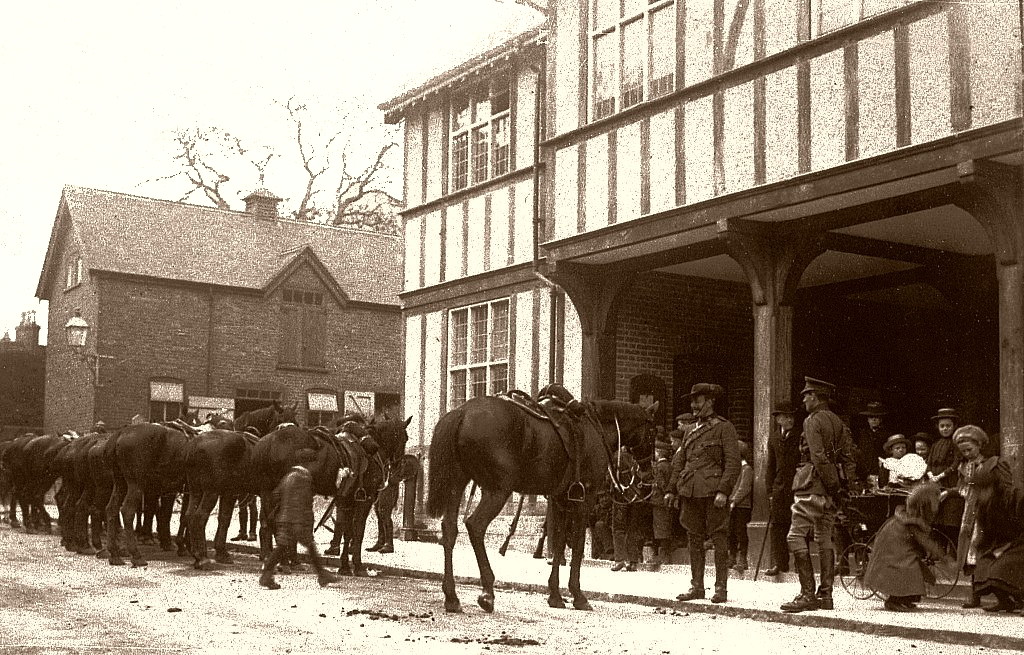
Cavalry in Akeman Street.
PRENTICE TO YOUNG
|
HARRY PRENTICE
Private, 2nd Oxfordshire and Bucks Light Infantry, service no. 2901.
Son of Frederick and Eliza Prentice of 49 King Street, Tring.
Enlisted at Aylesbury. Killed in action on the 19th July 1916
aged 18.
Buried in Laventie Military Cemetery, La Gorgue, France, grave ref.
III. C. 24.
Headstone inscription: GOD BE WITH YOU TILL WE MEET AGAIN.
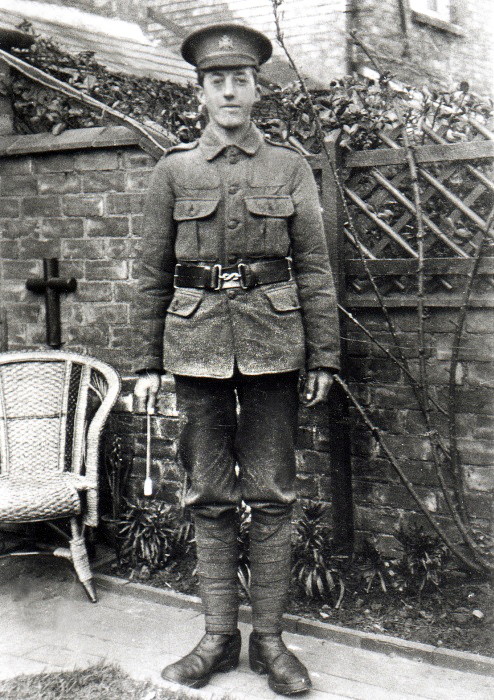
It appears that Private Prentice was another victim of the
slaughter at Fromelles (see
Sidney Pratt).
As planned, the Battle of Fromelles (19th-20th July, 1916) aimed to prevent the Germans moving
troops away from the Fromelles sector to the Somme battlefield
fifty miles to the south, and possibly forcing the German High
Command to move more troops from the Somme to support those at Fromelles. It also aimed to eliminate a salient (the
Sugarloaf) occupied by German forces that gave them observation
over no man’s land on either flank. The attack was
masterminded by Lieutenant-General Richard Haking, commander of
the XI Corps, [Note] one
of the few generals to earn a ‘donkey’ reputation while the war
was still in progress rather than after it.
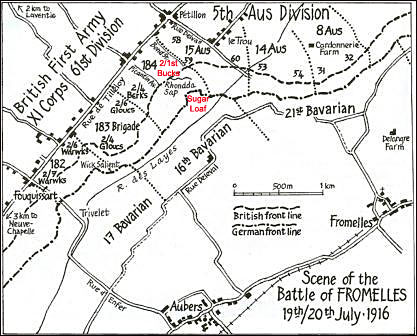
Battlefield map showing 2/1 Bucks.
Two divisions of XI Corps of the First Army took part in the
attacks, the British 61st and the Australian 5th. Both had
recently arrived in France and were devoid of combat experience.
Against them was the experienced 16th Bavarian Reserve Division
(whose numbers are believed to have included Corporal Adolf
Hitler). The infantry attacked at 0600 and was immediately
subjected to intense machine gun fire and shelling in a 300
metres-wide section of no man’s land, four waves of which were
mown down in succession. Some Australian soldiers
succeeded in penetrating the German lines, but they were quickly
isolated and subjected to counter-attacks. No man’s land
became filled with the bodies of dead and wounded, some likening
the macabre scene to a giant butcher’s stall.
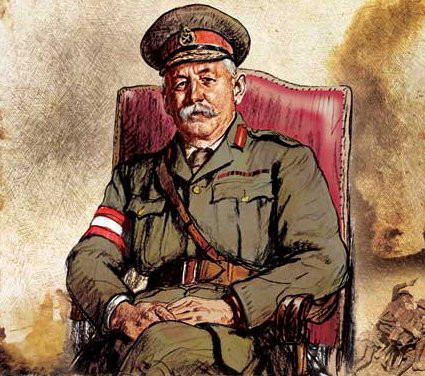
The architect of Fromelles, General
Sir Richard Haking [Note]
In spite of the initial failure a second attack was launched at
9 a.m. Totally isolated after a night in the German
trenches, the Australian survivors of the first attack attempted
to regain their lines on the morning of the 20th July, but the
enemy’s machine guns once again took many casualties. In a
period of twenty-four hours the Australians lost 5,533 men and
the British 1,400 with absolutely nothing to show for this loss.
Private Prentice was killed in action of the 19th July.
The following extract is from the War Diary [Note] of the 2/1 Ox and
Bucks Light Infantry for that date:
“July 19th: ‘Zero’ was at
11am, and at that hour our bombardment started.
5.30 p.m.: by 5.30pm we had lost nearly 100 men killed
and wounded by shell fire. This was serious as on July 18th ‘A’ coy
(which was holding the Battn. front) lost 78 men gassed - owing to
one of OUR shells having burst on gas cylinders in our trenches.
The Battalion went into action with 20 officers and 622 other ranks.
This was reduced by casualties suffered during the action to 6
officers and 300 O.R.
5.40 p.m.: What was left of ‘A’ and ‘D’ coys (the
assaulting coys) − about 120 men − filed into NO MANS LAND by
RHONNDA SAP, and lay down in 4 waves.
6 p.m.: with a cheer, the four waves leapt up and
assaulted the enemy’s trenches. Even before 5.40 p.m. the
enemy’s machine guns had become busy, and at 6 p.m. they mowed down
our advancing waves, so that only a few men actually reached the
German parapet. These did not return.
Telephone communications between Battalion Battle HQs and Front Line
was soon cut (about 1 p.m.). After many gallant attempts to
mend the wire, success was obtained at exactly 5.40 p.m. and from
5.40 till 9.30 p.m. the telephone was in constant use and saved many
lives − in that the runners were spared.
Reports that flowed in over the telephone were sent on − as they
came in − straight to BDE [Brigade]
HQs and were very contradictory. Owing to the distance between
the trenches and the continuous bombardment and smoke, the officers
who were observing found this task almost impossible of fulfilment
with any degree of accuracy. Seeing our own men actually on
the German parapet it was concluded that a certain number must have
got in. But it is certain that very few survived the enemy’s
machine gun fire and whether they got in or not they never returned.
C coy (the coy. which carried out R.E. material for consolidating
purposes) went out into NO MANS LAND at 6.10 p.m. but, again, the
enemy’s machine gun fire prevented any advance without
extermination.
6.30 p.m.: by 6.30 p.m. it
was clear that (1) the attack could not succeed without more men (2)
that given more men (say two coys) the attack must have succeeded.
No reserves, however, were available and the Commanding Officer of
the Battn. was ordered to reorganise and to attack again at 8.30
p.m. This order was received at a time when every man,
save a few telephone operators, orderlies and wounded, was in NO
MANS LAND. Gradually about 80 men (of A, C, & D coys) were
reorganised, and 40 men of B coy (the reserve coy) were added.
7.30 p.m.: the order came to postpone attack till 9
p.m.
8 p.m.: and at 8 p.m. the order came through that no
further attack would take place that night. Every officer who
went out with the assaulting coys was either killed or wounded and
Capt. H. S. G. Buckmaster was the only officer who went out into NO
MANS LAND who came back physically unhurt.
During the 18th and 19th July the Battalion lost 322 ALL RANKS as
follows:
Killed: Capt. H. C. Church; Lieut. C. P.
Phipps; 2nd Lieuts. H. R. N. Brewin and F. R. Parker.
Died of wounds: Lieut. D. G. Chadwick.
Wounded: Capt. I. Stewart-Liberty and V. W. G. Ranger; 2nd Lieuts.
H. G. Baddeley, A. T. Pitcher, B. H. Drakes, G. D. W. Oliver, T. J.
Relf and J. S. Rutherford.
Other ranks: killed, 62; wounded 180; missing 65.
The whole attack was unsuccessful in that
the enemy's trenches, though penetrated, were not consolidated and
held, but a very great measure of success was obtained in that (1)
the enemy suffered severe casualties (2) he was and will be
prevented from withdrawing either infantry or guns for the support
of his forces further South on the SOMME.
One of the most striking lessons to be learnt from this attack
is that the very greatly superior method of holding trenches adopted
by the Germans should at once be followed by the British and French
armies. Whereas on our Battn. front the Regt. had NOT ONE bomb-proof
shelter, and lost 100 casualties from shelling alone, the Germans
appeared to have about 6 teams of machine gunners, and very few
infantry, and even after seven hours of bombardment by our guns,
these six teams of machine gunners appeared intact, firing over the
parapet at our assaulting infantry.
By crowding three companies into three hundred yards of front, our
casualties from shell-fire were the more heavy.”
From the Bucks Herald 5th August 1916:
“THE WAR. − PRIVATE
HARRY PRENTICE KILLED.
− News was received at the end of last week that another Tring lad
had lost his life in the great advance. Harry Prentice, of the
Bucks Territorials, was the eldest son of Mr. and Mrs. F. Prentice
of King-street, and though then not quite 17, joined up soon after
the outbreak of the war. He went to the Front last May.
No particulars beyond the fact that he was killed on the night of
July 19th are yet to hand. His parents received a letter from
the Sergeant-Major of the Company, in which he speaks of Harry as a
quiet, unassuming boy, always ready to do his bit without a grumble,
and as one who would be much missed by his comrades. The
Chaplain of the 2/1 Bucks Battalion, in a letter expressing his deep
sympathy and sincere regret, said: ‘I thought it might be a comfort
to you to know that I buried him with his comrades in a burial
ground, where a cross has been erected over his grave with name on,
etc. His grave will be well cared for.’”
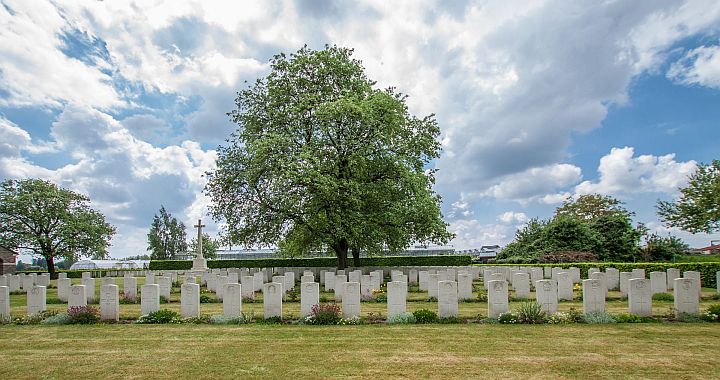
Laventie Military Cemetery is located in the commune of La Gorgue in Northern France. The cemetery is half a mile
northeast of the centre of the municipality of Laventie, but in the
territory of La Gorgue.
For most of the war the villages of Lavence and La Gorgue lay in
allied territory. The cemetery was started by the 61st (2nd
South Midland) Division in July 1916 and also used by other British
units during 1916 and 1917. It remained in use until April
1918, when the area fell into enemy hands during the German Spring
Offensive. [Note] After the German
withdrawal, more burials took place in September 1918.
There are now 468 British (including 8 unidentified), 5 Australians,
71 Indians (including 43 unidentified), 1 unidentified Chinese
(employed by the Chinese Labour Corps ) and 3 Germans (including 1
unidentified) buried in the cemetery.
――――♦――――
ARTHUR HENRY RANCE
Corporal, 62nd Machine Gun Corps (formerly with the London
Regiment), service no. 66504.
Born in Tring. Son of Henry and Mary Rance, Husband of Alice
of ‘Glenside,’ Bulbourne, Tring.
Formerly employed as a draper’s assistant.
Killed in action on the 9th June 1918 aged 33.
Buried in Bienvillers Military Cemetery, France, grave ref. XXI. C. 6.
From the Bucks Herald 2nd September 1911:
“Wedding. On Saturday, August 26th,
in delightful weather, an interesting wedding was celebrated at New
Mill Baptist Church between Miss Alice Bovington, second daughter of
Mr R. J. Bovington of Wingrave Road, New Mill and Mr Arthur H. Rance
of Tring. There was a large attendance of relatives and friends at
the service. The ceremony was performed by the Rev. C. Pearce,
the pastor at New Mill, the Rev. T. Percy George being away from
home on his holiday. The Hymn ‘The Voice that breathed o’
Eden’ was sung during the service, and Miss J. Clark, the organist,
played a selection of festival music while the guests were
assembling and again while the register was being signed. The
bride was charmingly attired in a dress of cream silk. She was
accompanied by Miss Olive Ruth Bovington (sister) as “best girl”.
Two children Iris Rosa Bovington (sister) and Frederick Kent were in
attendance. Mr Bovington gave his daughter away and Mr
Frederick Kent sen. was best man. Mr and Mrs Rance left Tring
later in the day for Leigh-on-Sea.”
Prior to the formation of Machine Gun Battalions, a Machine Gun
Company was attached to each Infantry Brigade and their subsequent
Division.
Following the formation of the 62nd Machine Gun Company at
Grantham, it moved to France where it joined the 62 Infantry Brigade
of the 21st Division on the 4th March 1916. On the
reorganisation of machine gun companies into battalions, on the 24th
February 1918 the 21st Machine Gun Battalion was formed from
the Machine Gun Companies of the 21st Division. [Note]
During 1918, they were in action during the Battle of the Lys, the
Third Battle of the Aisne, The Second Battle of the Somme, the
Battles of the Hindenburg Line and the Final Advance in Picardy.
At the Armistice the Division were around Berlaimont, on the 12th
they moved to Beaufort, then in mid-December they moved west of
Amiens and began demobilisation, which was completed by the 19th May
1919.
The brief obituary in the Bucks Herald (below) states that
Corporal Rance was killed by a shell, but if this was so the
circumstances appear not to have been known. The Battalion
War Diary [Note] for the 9th June (and preceding days) suggests that
the Battalion was undergoing training − indeed the whole of June
appears to have been devoid of fighting, which is in sharp contrast
to the end of May when the Battalion appears to have been in the
thick of action stemming the German Spring Offensive: [Note]
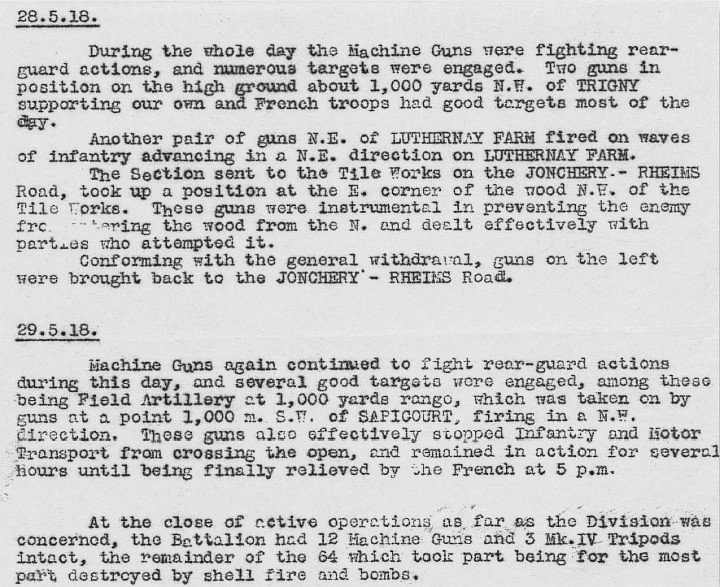 |
|
From the Bucks Herald 22nd June 1918:
“The war has made yet another claim in the
town by the death of Corpl. Arthur Henry Rance, M.G.C., on Sunday 9
June, and much sympathy is felt with his bereaved wife and
relatives.
Although he left Tring a few years ago, Corpl. Rance was well known
in the town, as for some eight years he was assistant in the
establishment of Mr. E. K. Fulks, draper and outfitter, and whilst
there, and also in his younger days, he was held in high esteem by
all. He was 34 years of age, and married, his wife being the second
daughter of Mr. R. J. Bovingdon, Glenside, Bulbourne, with whom she
had been residing for some time.
Before joining the Army he was in business in London, which he
disposed of when he was called to the Colours. The Chaplain in
conveying the sad news to Mrs. Rance, said he understood he was
killed by a shell, but had not been able to see anyone who has
actually been present at the time.
The body has been laid to rest in the British Military Cemetery at
Bienvillers au Bois. His officer wrote: − ‘His comrades are deeply
grieved, as he was much loved by his men, and they wish me to tender
their deep sympathy in your great trouble. Perhaps it will console
you to know that his death was instantaneous, and he did not suffer
any pain.’
Corpl. Rance joined the army in August 1916, and went to France in
the following March.”

Bienvillers Military Cemetery was begun in September 1915 by the
37th Division, carried on by other Divisions in the line until March
1917, reopened from March to September 1918, when the village was
again near the front line, and completed in 1922-24 when a number of
graves, mainly of 1916, were brought in from the battlefields of the
Ancre. Its twenty-one plots show a remarkable alternation of
original burials in regimental or divisional groups, and groups of
concentrated graves.
The cemetery now contains 1,605 Commonwealth burials and
commemorations of the First World War. 425 of the burials are
unidentified but there are special memorials to two casualties known
or believed to be buried among them.
――――♦――――
HARRY RANCE
Bugler, 58th Canadian Infantry (Central Ontario Regt.), 451060.
Charles Street, Tring.
Died of cerebro-spinal meningitis at Cambridge Military Hospital on
the 6th January 1916 aged 22.
Buried in Tring Cemetery, grave ref. E 119.
From the Hertford Mercury and Reformer 22nd January 1916:
“The death occurred last week of Bugler
Harry Rance of the 58th Canadian Light Infantry, son of Mrs. Rance,
38 Charles Street, Tring, and the late Mr. W. Rance, formerly
bandmaster of the Tring Band, and a Band-Sergeant in the old
Berkhamstead Volunteer Battalion Band. Deceased, who was 22
years of age, came over with the Canadian Contingent, and visited
his home at Tring for Christmas leave. While home he was
seized with illness, and was certified to be suffering from cerebro-spinal
meningitis. He was removed to Cambridge Military Hospital, where he
died.”
From the Bucks Herald 15th January 1916:
“On Wednesday afternoon Bugler Harry Rance, of the Canadian Light
Infantry, was buried at the New Cemetery, Tring, with military
honours. Bugler Rance was a son of the late Mr. William Rance,
and went to Canada a few years ago. On the outbreak of the war
he joined the Canadian Expeditionary Force, and came to this
country. While spending a short leave at his home in Tring he
was taken ill, and the military medical officers diagnosed his
disease as cerebro-spinal meningitis. He removed to Cambridge,
where special facilities exist for treating this mysterious malady,
but died on the 6th, aged 22.
The body was brought home on Saturday. The funeral procession
from his home in Charles-street to the Cemetery was most impressive.
Members of the Harts Territorials formed the firing party, and the
Band of the Cambridgeshire Territorials played as the cortege moved
slowly along.
At the graveside the service was taken by the Rev. H. Francis, vicar
of Tring, and one of the Army Chaplains. On the advice of the
military medical authorities it was decided not to take the body
into church. At the conclusion of the prayers two verses of
‘Abide with me’ were sung, and with the firing of a volley over the
grave and the sounding of ‘The Last Post’, the impressive and
reverently conducted service concluded.
Floral tributes were sent ‘From his loving mother’; ‘His sisters and
brothers’; ‘Cousins Hettie and Charles’; ‘Fred, Lizzie and Nancy’;
‘Aunt Ellen’; ‘A soldier’s mother’; ‘Mr. and Mrs. F. Budd’; the
Brentford officers of the 58th Battalion C.E.F., the Brentford
Platoon, C Company, 58th Batt., C.E.F., and the Bugle Band of the
58th Batt. C.E.F.”
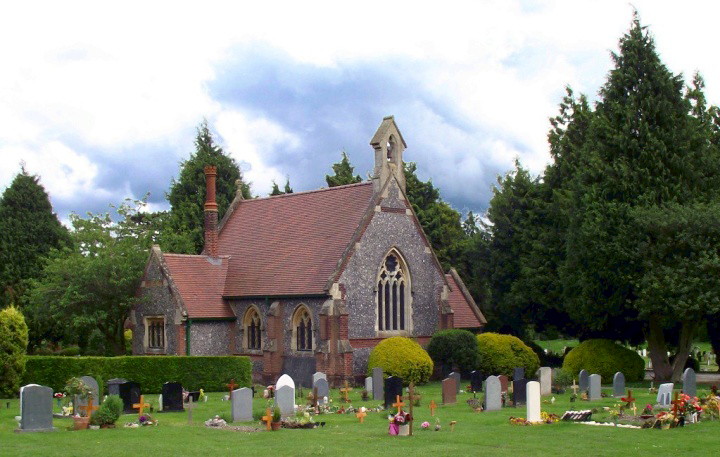
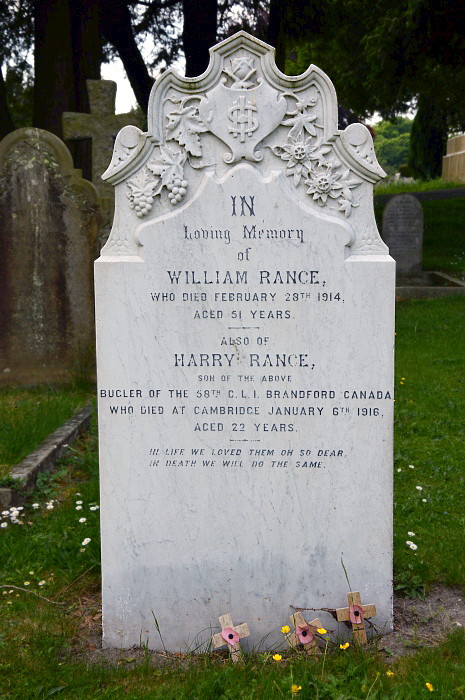
――――♦――――
WALTER RANCE
Lance Corporal , 2nd Queen’s Royal West Surrey Regiment.
Enlisted at Bedford, service no. 265718.
Killed in action in Italy on the 29th October 1918 aged 30.
Born in Tring. Husband of Elsie A. Rance of 35 Albert Street,
Tring.
Buried in Tezze British Cemetery, Italy, grave ref. plot 4. row A. grave
14.
The Italians entered the war on the Allied side, declaring war on
Austria in May 1915. Commonwealth forces were at the Italian
front between November 1917 and November 1918.
On the 21st October 1918, Commonwealth forces comprising the XIVth
Corps (7th and 23rd Divisions), which had been transferred from the
Asiago sector, took over the part of the River Piave front from
Salletuol to Palazzon, serving as part of the Italian Tenth Army.
On the night of the 23rd October, the main channel of the river was
crossed using small boats and the northern half of the island of
Grava di Papadopoli was occupied, the occupation being completed two
nights later by a combined Commonwealth and Italian force.
After capturing the island, the bridging of the Piave proceeded
rapidly, although the strength of the current meant that the two
bridges built for the crossing were frequently broken and many men
were drowned. The Allied attack east of the Piave began early
in the morning of the 27th October. Despite stiff resistance
and difficulties with bringing forward supporting troops across the
river, the Austrians were forced back over the next few days until
the Armistice came into effect on the 4th November.
The following are extracts from the 2nd Battalion’s War Diary
[Note]
covering their operations from late on the 28th October to the 30th.
It isn’t apparent from this record what happened to Lance-Corpl.
Rance (or to others in “A” Company), but his name is recorded among
the fatalities sustained by “A” Company in the final section below:

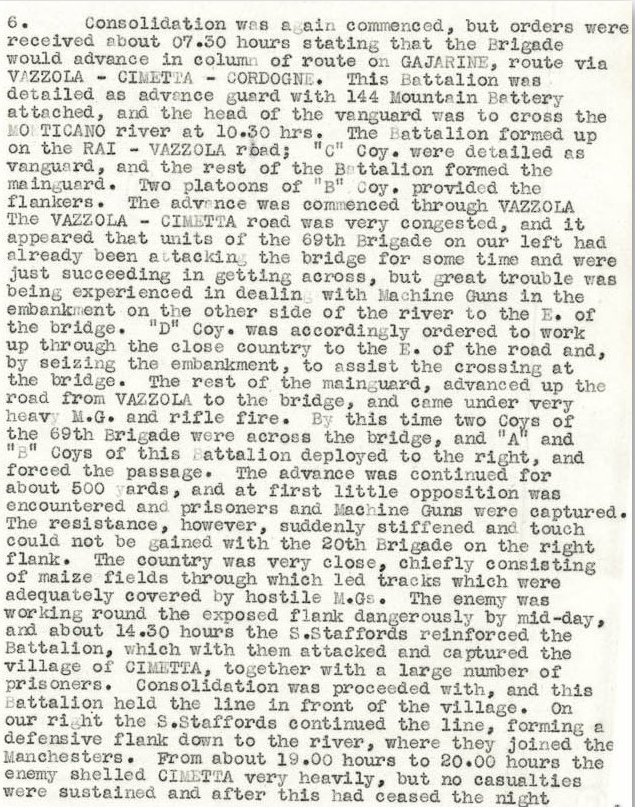
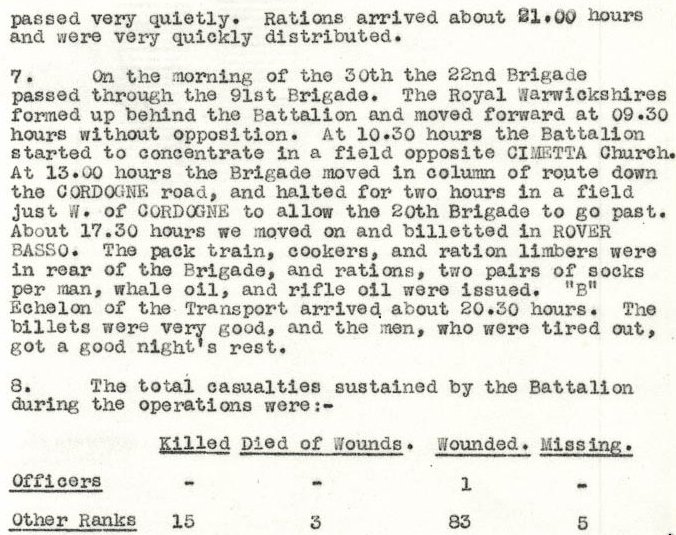
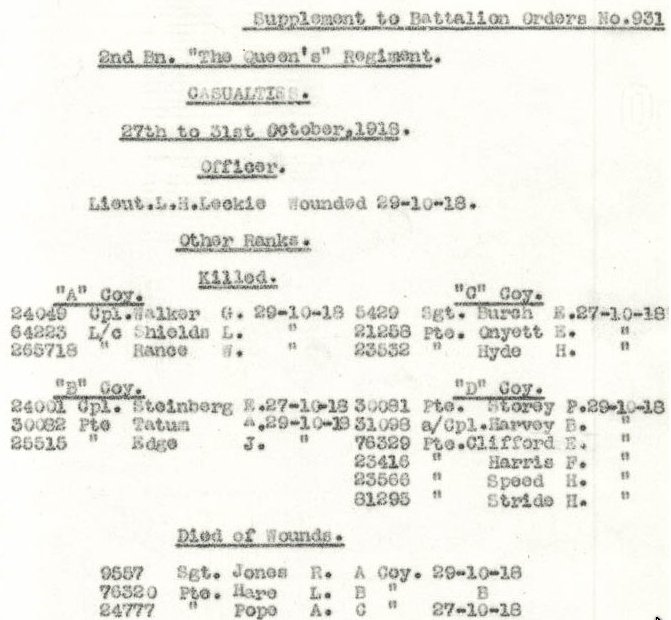
From the Bucks Herald 16th November 1918:
“Lance-Corpl. Walter Rance, Queen’s Royal
West Surrey Regiment, resided at Unity Cottages, Albert Street, and
joined the Army some two years ago. He served six months in
France and twelve months in Italy. On Wednesday morning his
wife received the sad news that her husband was killed by a shell in
October last. His officer, in conveying his sympathy,
described Corpl. Rance as a brave and cool man, and a splendid
example to the gun team, which he commanded.
Rance was a member of the Tring Fire Brigade, and before joining up
was employed by Messrs. J. Honour and Son [builders].
He leaves a widow and two young children.”
From the Parish Magazine December 1918:
“K.I. A. 30th October 1918, during the big
offensive in Italy. He joined up two years ago and after his
training, served for six months in France, where he was wounded and
then for twelve months in Italy. In former days he was a
member of the Y.M.C.A and in our Local Fire Brigade. His
lieutenant writes: ‘It is with deepest sympathy and regret that I
have to tell you, that your husband was killed in action on October
30th. A few minutes after we came in to action on that morning
(about 10. a.m.) your husband was struck by a shell, while laying
alongside me, and you will be comforted to know that he could have
suffered no pain, as he died within a couple of minutes. Your
husband was a very cool and brave man, and a splendid example to The
Gun Team he commanded. He was a most willing and capable
soldier, and a very popular with all who knew him, and his loss is
keenly felt by us all, and especially by myself, who was his Platoon
Officer. He died, upholding the best traditions of an
Englishman and a Soldier.’”

Tezze is a village in the Province of Treviso, a large town north of
Venice. It was captured by the Austrians in the advance in the
autumn of 1917 and remained in their hands until the Allied forces
crossed the River Piave at the end of October 1918. Many of
those who died on the north-east side of the river during the
Passage of the Piave are buried in the Tezze British Cemetery, which
now contains 356 Commonwealth burials of the First World War.
――――♦――――
SIDNEY JAMES RANDALL
Private, 44th (New Brunswick) Canadian Expeditionary Force, service
no. 2225677
Born 16th July 1897. Son of Mr. A. E. Randall, Albert-street,
Tring.
Died of wounds on the 12th November 1918 at the General Military
Hospital, Rouen, France.
Buried in St Sever Cemetery Extension, grave ref. S. III. AA. 24.
The 44th Battalion (Manitoba) was an infantry battalion of
the Canadian Expeditionary Force. It embarked for the U.K. on
the 23rd October 1915, moving to France on the 12th August 1916.
It then fought as part of the 10th Infantry Brigade, 4th Canadian
Division [Note] in France
and Flanders until the end of the war. In August 1918, the
44th Battalion was renamed the 44th Battalion (New Brunswick),
Canadian Expeditionary Force. |
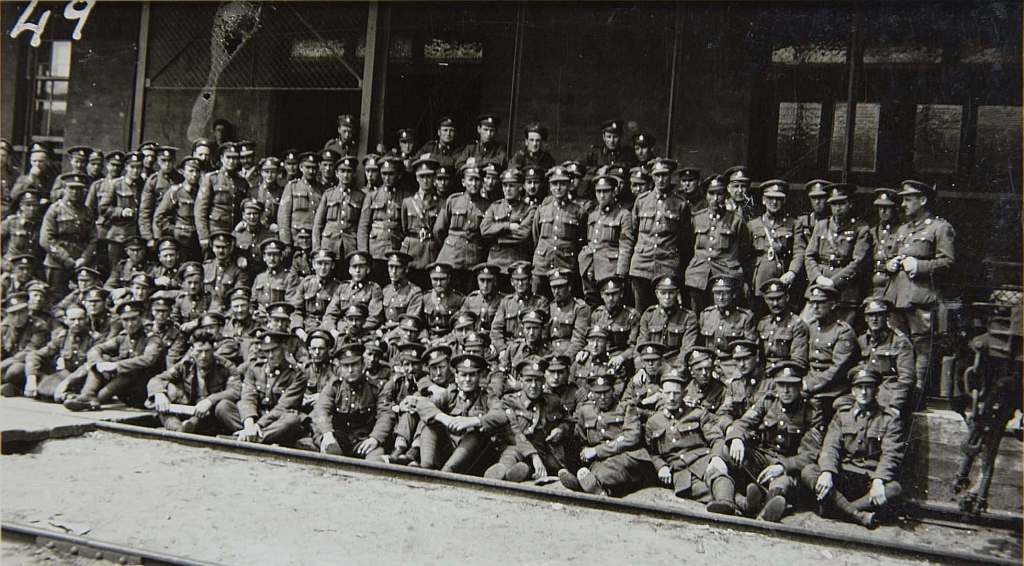
Archives of Manitoba: of all the “Originals” from
the 44th and 61st Battalions, only 100 came home.
|
Private Randall died of shrapnel wounds on the 12th November, 1918,
but the Battalion War Diary [Note] gives little help on the
circumstances in which these were acquired:
“Fri,
Nov 8, 1918: the Battalion moved forward to billets in
THULIN, arriving there at dusk. Four casualties (wounded)
occurred from enemy shell fire immediately after the Battalion had
arrived.
Sat, Nov 9, 1918: the Battalion was ordered again to
move forward by Route March to JEMAPPES which was reached at 19.00
Hours. The route was via BOUSSU - HORNU - QUAREGNON.
Throughout the whole march the streets were lined with cheering
civilians who gave the Battalion a tremendous reception.
Sun., Nov 10, 1918: on the morning of the 10th the
Battalion relieved the P.P.C.L.I. and took over a Company of the
R.C.R. The area extended from the CONDE-MONS Canal to the
HYON-QUESMES Road in Q.13.C. As soon as this was completed the
Battalion commenced to press the attack on MONS from the Western and
Southern outskirts and penetrated the city and the neighbourhood of
the Railway Station at 01.00 Hours on the 11th. During the
afternoon, while the enemy were shelling JEMAPPES, the Battalion
suffered most unfortunate casualties in its Transport Lines.
An H.V. shell burst in the Farrier’s workshop killing two men
outright and wounding ten others, four of whom afterwards died of
wounds. The majority of these men had come with the
Battalion from Montreal and had been with it for thirty-seven months
in France.”
However, the Manitoba Government website holds a
listing (.pdf, 5.4MB) of soldiers from the province who are
known to have perished in the Great War. It includes an entry
for Private Randall, stating that his occupation was that of a
blacksmith. Thus the reference in the War Diary above
(10th November) to a shell exploding in “the
Farrier’s workshop”, a place in which you might
expect a blacksmith to be working, might refer to the incident in
which Private Randall lost his life.
From the Bucks Herald 23rd November 1918:
“ROLL OF HONOUR.
− We regret to learn that two more families of the town have
suffered bereavement by the loss of sons in France. Sidney
Haystaff was the only son of Mr. and Mrs. H. Haystaff of
Brook-street. He belonged to the Canadian Grenadier Guards,
and was killed in action on Nov. 5. − Sidney James Randall, son of
Mr. A. E. Randall, Albert-street, died of wounds in the General
Military Hospital, Rouen, on Nov. 12.
Both these men emigrated to Canada as lads, and they joined the
forces about a year ago. Randall was a member of the Tring
Y.M.C.A., and Haystall one of the first, and certainly one of the
most proficient, members of the Tring Company, Church Lads Brigade.”
From the Parish Magazine December 1918:
“Sidney James Randall. 44th BN Canadian
Infantry, died in the General Hospital at Rouen on November 12th
1918, as the result of severe shrapnel wounds.
He joined up in Canada twelve months ago, and went to France last
August. As a lad, he was a member of the Y.M.C.A. in Tring,
and is affectionately remembered by all who knew him here.”

St. Sever Cemetery Extension is located within a large communal
cemetery situated on the eastern edge of the southern Rouen suburbs
of Le Grand Quevilly and Le Petit Quevilly.
During the First World War, Commonwealth camps and hospitals were
stationed on the southern outskirts of Rouen. A base supply
depot and the 3rd Echelon of General Headquarters were also
established in the city. Almost all of the hospitals at Rouen
remained there for practically the whole of the war. They
included eight general, five stationary, one British Red Cross and
one labour hospital, and No. 2 Convalescent Depot. A number of
the dead from these hospitals were buried in other cemeteries, but
the great majority were taken to the city cemetery of St. Sever.
In September 1916, it was found necessary to begin an extension in
which the last burial took place in April 1920.
The cemetery extension contains 8,348 Commonwealth burials of the
First World War, ten of them unidentified.
――――♦――――
DOUGLAS JOLLAND REW
Second Lieutenant, 5th Essex Regiment.
Son of Major and Mrs. H. G. Rew of 61 Norbury Court Road, Streatham,
London.
Assistant scoutmaster at Tring.
Killed in action in France on the 28th June 1917 aged 33.
Buried in Philosophe British Cemetery, Mazingarbe, Pas-de-Calais,
France,
grave ref.
plot 1,
row 5, grave 32.
Although the Commonwealth War Graves Commission list 2nd Lieut. Rew
as a member of the 5th Battalion Essex Regiment, which he may have
been, he was not killed while fighting with that unit, which served
at Gallipoli and in the Middle East. The Roll of Honour of the Artists Rifles,
his former regiment, lists 2nd Lieut. Rew
as being near Loos and on the strength of the 11th Essex at the time
of his death . . . .

Artists Rifles. Regimental Roll of
Honour and War Record 1914-1919.
and it is in the War Diary [Note] of this unit for the 28th June
1917 that his death is reported.
At the time the men of the 11th Essex were in the trenches near Les Brebis, a
small hamlet north west of Grenay and Maroc in the Loos sector.
On the evening of the 28th June they carried out a raid on the
opposing German
trenches, the general objective of which was:
“11th Essex Operation Order No. 91.
The Battalion will carry out a raid on the enemy’s trenches on the
28th instant in conjunction with the 2nd Durham Light Infantry, who
will raid on our immediate right (South).
Object: to take prisoners, obtain identification, and destroy
dugouts and mine shafts.”
The report of the raid makes no mention of Rew’s death − although it
does refer to two unnamed officers being killed − but the
Battalion’s daily log does:
“1st Army, 1st Corps, 6th Divn, 18th I.B.,
[18th Infantry Brigade] 11th
Battn. Essex.
28th June, 7.10pm: Capt. Silver’s party raided the
German trenches. All desired ends were attained. A
prisoner was captured, the party remained in the German line the
full hours appointed, mine shafts and dug outs were destroyed, a
large number of Germans were killed and much artillery fire was
diverted from the operations of the 46th Divn. on our right.
For details see orders and reports in App. I, II, and II. 2nd
Lieuts WEARNE and REW killed.
A very quiet day. Trench strength 177 offs 437 other ranks. Lieut M.
R. Robertson [?] who led the
party over was twice wounded.
The Battalion was relieved by the 14th D.L.I. [Durham
Light Infantry] and proceeded to billets in
LES BREBIS.”
With regard to casualties suffered during the raid, the official
report goes on to say “A list of casualties
will be forwarded [not attached to the War Diary].
I regret they are heavy. Two officers
are known to have been killed and one wounded.
Enemy’s retaliation was particularly heavy,
causing a number of casualties in our lines.”
Perhaps this “retaliation” was
the “bombardment” referred to
below in which Rew was killed?
From the Essex Newsman 28th July 1917:
“Sec-Lieut. Douglas Jolland Rew, Essex
Regt., killed during a heavy bombardment on June 28, was the third
son of the late Major H. G. Rew and Mrs Rew of 22 Queen’s Road,
South Norwood. He obtained his commission in the Essex Regt.
from the Artists’ Rifles O.T.C., and served at the Front with the
13th Essex Regt., being severely wounded. He returned to the Front
last April, being posted to another battalion, and was again
wounded.”
From the Parish Magazine August 1917:
“2nd/Lt Douglas Rew was not for long a
resident of Tring, but during his period of residence here he
rendered good service. For nearly two and a half years, he
acted as Assistant Scout Master to our troop. He proved
himself a most conscientious and willing worker. The scouts
are not likely to forget the interesting problems that he used to
set them on a Saturday afternoon, and the help he gave on the
allotments and on the football field, or at fretwork table in the
clubroom. He was able sometimes to take a class in Sunday
School but most of his Sundays were devoted to Cheddington Church,
where he read the lesson.
Soon after leaving Tring, he joined the Artists Rifles and from that
Corps, obtained a commission in the Essex Regiment. Part of
his training was done at Halton Camp. He was twice wounded
whilst in France, but returned to duty until, on June 28th he was
called to higher service. His officer comrades wrote to him;
‘He was always self reliant and thorough in what ever he took up,
and was one to do his absolute duty’. He was killed, together
with two of his men, whilst visiting them during a heavy German
bombardment. His Captain writes that his death must have been
instantaneous.”
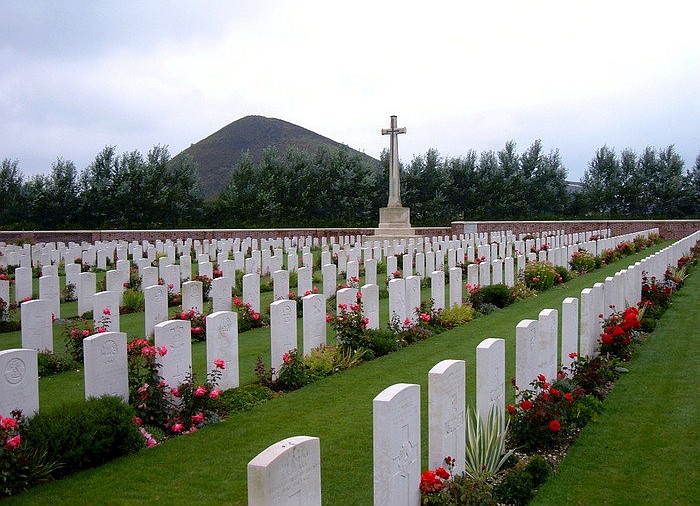
The Philosophe British Cemetery was started in August 1915. In
1916 it was taken over by the 16th (Irish) Division, who held the
Loos Salient at the time, and many of their dead were brought back
to the cemetery from the front line. Succeeding divisions used
the cemetery until October 1918, and men of the same Division, and
often the same battalion, were buried side by side.
After the Armistice, this cemetery was one of those used for the
concentration of isolated graves from the Loos battlefield.
The bodies of 41 men of the 9th Black Watch were brought from
positions a little West of Loos, and those of 340 officers and men
of other Regiments from different points in the communes of Cambrin,
Auchy, Vermelles, Halluch and Loos.
There are now 1,996 Commonwealth burials of the First World War in
the cemetery, 277 of them unidentified.
――――♦――――
THOMAS WALTER ROBERTS
Private, 7th East Surrey Regiment. Enlisted at Watford,
service no. 2857.
Born in Tring. Son of Walter and Mary Ann Roberts of The Gas
Works, Brook Street, Tring.
Killed in action on on the 23rd July 1916 aged 18.
No known grave. Commemorated on Thiepval Memorial, France,
ref. pier
and face 6 B and 6 C.
The Commonwealth War Graves Commission record states that Private
Roberts was attached to the 7th East Surrey Regiment, but obituary
notices in the Parish Magazine and Bucks Herald −
presumably based on reliable information − go on to say that he was
fighting with the Manchester Regiment at the time of his death, but
without stating with which of its numerous battalions.
Commemoration on the Thiepval Memorial narrows down the possible
actions to the Somme offensive, [Note] so within that boundary it is a
matter of looking to see what battalions of the Manchester Regiment
were in action on the 23rd July, the day on which Thomas Walters
disappeared. However, the account follows is unavoidably
speculative.
On the 1st July 1916, the first day of the Somme, the Manchester
Regiment had nine battalions committed, including the 16th (1st
City), 17th (2nd City), 18th (3rd City) and 19th (4th City), all
serving in the 90th Brigade of the 30th Division. [Note]
On the 23rd July at 3.40 a.m. the 30th Division attacked the French
village of Guillemont with one battalion from Trônes Wood and one
from Longueval Alley to the north. The bombardment of the
village and the trenches in front of it appeared to have been highly
destructive, as was a standing barrage by heavy artillery, but it
did not cut all the barbed wire. The
field artillery fired [Note] a creeping barrage
[Note] in four lifts through the
village, stopping on the south and east sides 45 minutes after zero
hour.
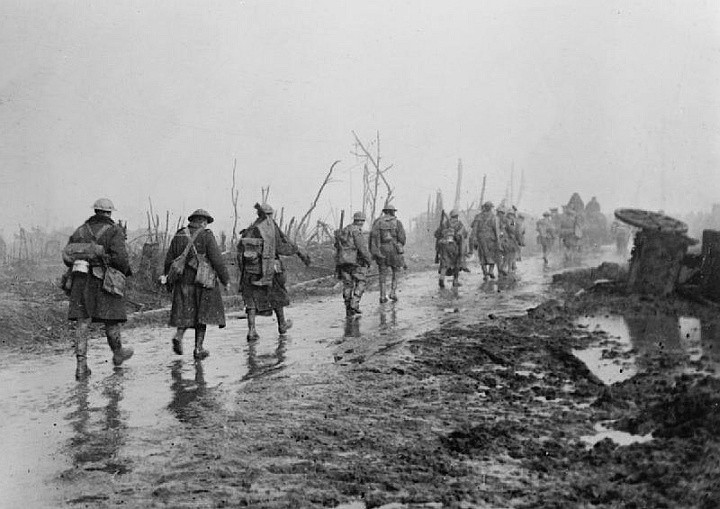
Soldiers leaving the trenches at Guillemont.
The 19th Manchesters moved
into Trones Wood where the men took advantage of the cover of shell
holes to await zero hour for the attack. The Battalion, which
had lost 14 casualties on the way up to Trones Wood, was shelled
continuously by the Germans during the night.
At 2.30 am, the Battalion moved into position for their attack.
‘A’ Company moved along the railway line and formed up to the north
of ‘C’ and ‘D’ Companies, with ‘B‘ Company in support behind them.
At 3.40 am the attack began and from the start it was subjected to
heavy German artillery, machine-gun and rifle fire. ‘A’
Company managed to negotiate the uncut barbed wire and passed
through the enemy front line without serious opposition but then
came under heavy fire from six to eight German machine guns on their
flanks and from the ridge in front of them. Nevertheless,
elements of the Company did reach Guillemont.
However, by 6.00 am it was clear that the 19th Manchesters’ attack
had failed and that the survivors would have to withdraw.
About 30 men of ‘A’ Company managed to reach British lines, but a
party holding a quarry outside the village was wiped out. ‘C’
Company, to their right, entered Guillemont in strength, some
reaching the eastern edge of the village and attacking the
headquarters of the German defenders, but they were steadily cut off
and surrounded. Very few managed to escape. ‘B’ and ‘D’
Companies suffered slightly less. By this time communications
with the rear had been cut by a German barrage in no-mans-land and
by a smoke screen that was intended to mask the attack from the
Germans.
For the Battalion, the attack on Guillemont was a disaster.
They suffered 571 casualties, over two thirds of their strength, of
whom no fewer than 496 men were recorded missing. That
evening the survivors withdrew to Glatz Redoubt, which they had
captured with distinction three weeks earlier.

The High Street, Guillemont, September
1916.
From the Bucks Herald 23rd June 1917:
“A MISSING SOLDIER.
− For some months past considerable doubt has been felt as to the
fate of Pte. Thomas Walter Roberts, son of Mr. W. Roberts, the
esteemed manager of the
Tring
Gas Light & Coke Company, Limited.
The young fellow, who was then only 17 years of age, joined the East
Surrey Regiment at an early stage in the war, and in June last year
was sent to France, being attached to the Manchester Regiment, with
which unit he went into action on July 23, 1916. He failed to
answer the roll-call after the engagement, and was presumed to be
‘missing’ or a prisoner. Enquiries have since been made, but
no trace can be found of him, and his parents have been notified by
the Army Council that they have been regretfully constrained to
conclude that he is dead, and that his death took place on July 23,
1916. Much sympathy has been felt with his parents in the long
strain of uncertainty which has hung over his fate for so many
months, and that this has been further extended now that the news of
a more definite, though regrettable, character has been received.”
From the Parish Magazine June 1917:
“Thomas Walter Roberts, who has been
missing since 23 July 1916 is now reported to have been killed on
that day; though no facts have come to light. He joined the
East Surrey Regt in 1914, giving his age as 17 years.
It was in June of 1916 that he went to France attached to The
Manchester Regiment. It was in the ‘push’ on the Somme that he
made the great sacrifice. All who knew Tom Roberts, speaks of
him as a thoroughly good chap.
May our lord, in his mercy, grant them rest and peace.”

Following Guillemont, the 19th Manchester Battalion was incapable of
further action for some time due to the heavy losses it had
sustained. Many of those killed on the 23rd July − Tom Roberts
among them − have no known graves and are commemorated
on the Thiepval Memorial to the Missing of the Somme.
The Thiepval Memorial bears the names of more than 72,000 officers and men of the
United Kingdom and South African forces who died in the Somme sector
before the 20th March 1918 and have no known grave. Over 90% of
those commemorated died between July and November 1916. The
memorial also serves as an Anglo-French Battle Memorial in
recognition of the joint nature of the 1916 offensive and a small
cemetery containing equal numbers of Commonwealth and French graves
lies at the foot of the memorial.
――――♦――――
FRANK ROBINSON
Private, 17th Tank Corps, formerly with the Hertfordshire Regiment.
Service no. 304916.
Born in Tring. Son of Thomas and Alice Robinson of Cherry Tree
Cottages, Cholesbury.
Killed in action on the 11th June 1918 aged 21.
Buried in St Martin-Aux-Bois Churchyard, France.
The Royal Tank Regiment’s formation followed the invention of the
tank. Tanks were first used at Flers in September 1916 during
the Battle of the Somme. At that time the six tank companies
were grouped as the Heavy Branch of the Machine Gun Corps (MGC) [Note].
In November 1916 the eight companies then in existence were each
expanded to form battalions; [Note]
another seven battalions were formed by January 1918.
On the 28th July 1917 the Heavy Branch was by Royal Warrant
separated from the rest of the MGC and given official status as the
Tank Corps, meaning that by the beginning of 1918 the fifteen units
were redesignated as the 1st to the 15th Battalion, Tank Corps.
More battalions continued to be formed, and by December 1918, 26 had
been created.
In April 1918 the 17th Battalion converted from tanks to armoured
cars, becoming known as the 17th (Armoured Car) Battalion, Tank
Corps. The Battalion was equipped with 16 Austin Armoured
Cars, the general specification for the 1918 series vehicles (there
were earlier types) being:
Designer and builder: the Austin Motor Company
Armour: 3–6 mm
Main armament: 2 x machine guns (Maxim or Hotchkiss)
Engine: Austin 4-cylinder inline, 4 stroke, water cooled petrol
engine of 50 hp (37 kW)
Power/weight: 9.5 hp/ton
Transmission: 4 speed, 1 reverse gearbox
Suspension: 4x2 wheel
Operational range: 125 miles (201 km) radius of action
Speed: 35 mph (56 km/h).
Weight: 5.3 tons
Crew: 4 or 5.
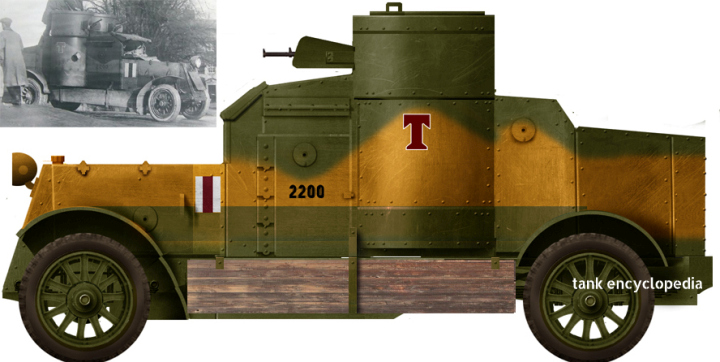
Austin armoured car, 1918 model.
The 17th Battalion arrived in France in April 1918. Its first
operations in June were to support the French Army. It
returned to the British Army in August and was very successful at
the Battle of Amiens. The Austins were towed in pairs by tanks
across the battlefield. Once they reached better ground on the
other side of the lines, they ranged freely. A German Corps
headquarters 10 miles back was captured and German reserves,
artillery and supply lines were shot up. The 17th was the
first British unit to cross the Rhine in 1918.
The following extract is taken from Tanks in the Great War
1914-1918 by Brevet-Colonel J. F. C. FULLER, D.S.O. (Oxfordshire
and Buckinghamshire Light Infantry) 1920. It leads up to an
action on the 11th June 1918 (the date of Private Robinson’s death)
in which the 17th Battalion was in action with French forces
attempting to stem the German Spring Offensive: [Note]
“In March 1918 the 17th Tank Battalion was
in process of formation at the Tank Training Centre at Wool, when
the German spring offensive resulted in so great a demand being made
on the home resources that it was converted into an Armoured Car
Battalion on April 23. On the following day the drivers were
selected, and sixteen armoured cars, which were earmarked for the
eastern theatre of war, were handed over to it, the Vickers machine
guns being replaced by Hotchkiss ones.
On April 28 the cars were embarked at Portsmouth, and on the 29th
the personnel, under the command of Lieutenant-Colonel E. J. Carter,
left Folkestone for Boulogne. Thus in six days the whole battalion
was formed, equipped, and landed in France.
Immediately on landing the 17th Battalion was attached to the Second
Army and ordered to proceed to Poperinghe, but the tactical
situation improving these orders were cancelled and it was first
sent to the Tank Gunnery School at Merhmont for instruction, and
later on to the Tank Depot at Mers.
After some ten days’ training
the 17th Battalion joined the Fourth Army and went into the line at
La Hussoye, being attached to the Australian Corps. A few days
later the battalion was transferred to the XXIInd Corps, which was
then resting in G.H.Q. reserve, immediately behind the right flank
of the British Army, and battalion headquarters were established at
Pissy. Here training continued until June 10, when at 9.30
a.m. instructions were received by Lieutenant-Colonel Carter to
report to the headquarters of the First French Army at Conty.
At Conty orders were issued for the battalion to proceed to Ravenel
near St. Just. The battalion was notified of this by
telephone, and, although the night was very dark and wet and the
roads crowded with traffic, it reached Ravenel by 5 a.m. on June
11, after a sixty-mile journey, and went into action with the
Tenth French Army in its counter-attack at Belloy on that day.
In this battle two sections of armoured cars engaged the enemy with
machine-gun fire, but the quantity of debris scattered on the roads,
and the fragile nature of the chassis of the cars, prevented their
being freely used. On the conclusion of these operations the
battalion returned to the XXIInd Corps.”
The page from the Commanding Officer’s Report in the Battalion
War Diary [Note]
for the 11th June 1918 is missing, but its final
sentences appears at the top of the page covering the following
day’s activities. They read:
“The Companies eventually rallied at
VAUMONT and parked for the night, with the exception of one car on
the TRICOT-COURCELLES road which was hit by Shell fire. This
car was recovered next day. Casualties, 1 Gunner killed,
1 driver slightly wounded.”
The 17th Battalion lost one man on the 11th June, and although he is
not named it follows that this was Private Robinson.
From the Parish Magazine October 1918:
“Frank Robinson joined The Herts
Territorials in February of 1914, and was among those camping in
Ashridge Park. Just before the war began at the commencement
of hostilities his regiment was mobilised and he was in France by
November 1914. He was invalidated home, but returned to the
front later on, and was attached to the tanks, and killed in action
on June 11th 1918 and buried in a cemetery about eight miles behind
the line. His Lieutenant, writing to his parents, says ‘I had
only known your son for seven weeks, but I found him to be cool,
cheerful and very popular among his comrades. He had just been
recommended for promotion and would have risen rapidly. He
leaves a gap in the ranks which is hard to replace and I had come to
rely on him, and never found my trust misplace.’ He was
evidently, as another officer, says ‘a very gallant soldier’”.
Saint-Martin-aux-Bois Churchyard contains one Commonwealth war grave
from the World War I . . . .
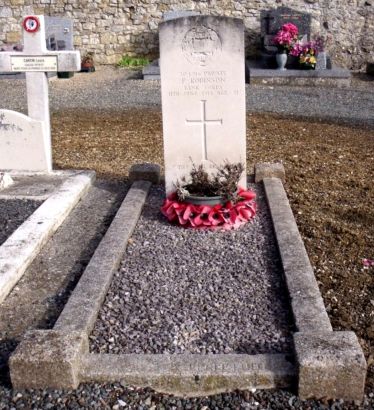
Private Frank Robinson,
‘A’ Company, 17th (Armoured Car) Battalion, Tank Corps.
――――♦――――
HORACE HEDLEY REGINALD ROLFE
Air Mechanic 2nd Class, 1st Wing HQ Royal Flying Corps, service no.
16186.
Died of wounds on the 26th September 1916 aged 25.
Son of Frederick (a coal merchant) and Agnes of Western Road,
Tring.
Husband of Doris C. (née Plater) of Green End Street, Aston Clinton.
Member of the United Free Church.
Buried in Barlin Communal Cemetery Extension, France, grave ref. 1D42.
Reginald Rolfe died of wounds on the 26th September 1916 after his
BE2c [Note] was hit by anti-aircraft
fire over enemy lines during air reconnaissance on the previous day.
So far as I can ascertain his pilot, 2nd Lieut. Reginald Stanley
Haward RFC [Note] was wounded in the
incident, but appears to have survived (and survived the war).
From the Bucks Herald 7th October 1916:
“News reached the friends of Airman H. H.
R. Rolfe last week that he was very ill in France, and that
permission could not be given for anyone to see him. The vague
nature of the communication naturally gave rise to the most alarming
surmises, and all attempts to obtain more definite information were
ineffective.
On Sunday a letter reached Tring from the sister in charge of the
clearing station [Cemetery records suggest this was No.6
Casualty Clearing Station at Barlin, west of Lens]
saying that Reginald Rolfe, who had been in the hospital wounded,
passed away on the evening of September 26. Further
particulars are given in a letter from a chum. It appears that
Airman Rolfe was crossing the enemy’s lines when his machine was hit
by a German anti-aircraft shell and he was badly wounded. He
did not fully recover consciousness after he was struck.
Several officers of the R.F.C. were present at his funeral, which
was conducted by one of the Chaplains to the Forces.
Horace Hedley Reginald Rolfe, who was always known as ‘Reggie’, was
the eldest son of Mr. and Mrs Frederick Rolfe, of Western-road,
Tring, and before joining the Colours was associated with his father
in business, taking a special interest in the firm’s motor traffic
undertakings. In December, 1915, he joined the R.F.C. as an
air mechanic, and after a short period of training at the Curragh,
Ireland, went to France. He was qualifying for a commission as
a flight lieutenant, and at the time of his last flight was
undergoing a period of probation as an observer.
‘Reggie’ Rolfe was a young man of great daring and courage; flying
always had for him a great fascination, and had his life been spared
− he was only 26 − he would doubtless have worthily sustained the
reputation of the R.F.C. for fearless valour. It is evident
from the letters received from his friends that ‘Reggie’ was very
popular among his comrades. He was a frequent and acceptable
performer at concerts got up by the men, his violin playing being
greatly appreciated.
The greatest sympathy is expressed to his young wife, his parents,
and the other members of his family. His early death is a
tragedy, but the circumstances of his death were just such as he
himself would have wished.”
From the Parish Magazine November 1916:
“Reginald Rolfe R.F.C. was hit by anti
aircraft fire on September 25th, while flying with his Lieutenant
over the enemy lines, and sustained injuries from which he never
recovered. The machine came down in our own lines and he was
laid side by side with hundreds of others who, like him, have made
the great surrender ‘he was’, as his Commanding Officer writes, and
we, who knew him in Tring, would have expected, ‘Very keen indeed on
his work, and showed exceptional promise, besides which he was
always so cheerful’. It was his great wish to be an airman,
and he died, as he would most eagerly have desired to die, doing his
duty.”
Reg’s young widow, Doris, received a letter of condolence from
Reggie’s commanding officer:
1 October 1916
. . . . I am sorry to say he was not with us for long. He came
on probation as an observer on the 20th of last month. On the
25th he went out with Lieut. Haward over the lines. They were
unfortunately hit by anti-aircraft fire, all the controls being cut.
The machine fell in our lines and some sappers immediately went to
the assistance of your husband and Lieut. Haward. I am sorry
to say that your husband sustained injuries in the crash, from which
he did not recover . . . .
Yours sincerely,
P. C. Maltby,
Royal Flying Corps, B.E.F.
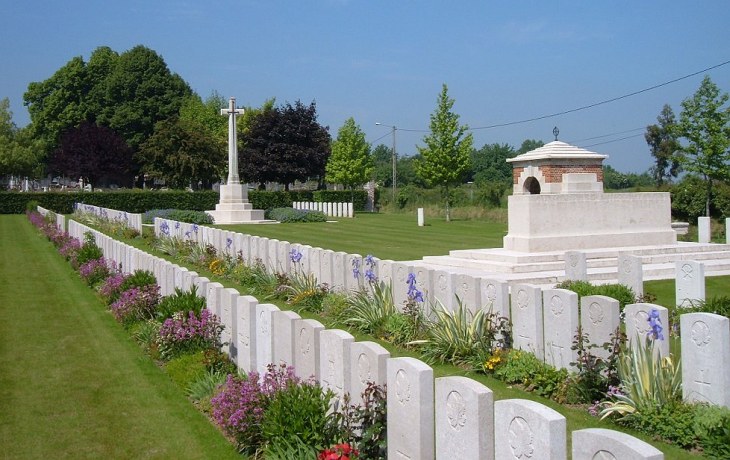
Designed by Sir Edwin Lutyens, the Barlin Communal Cemetery
Extension was begun by French troops in October 1914 and when they
moved south in March 1916 to be replaced by Commonwealth forces, it
was used for burials by the 6th Casualty Clearing Station. [Note]
In November 1917, Barlin began to be shelled and the hospital was
moved back to Ruitz, but the extension was used again in March and
April 1918 during the German advance on this front. The
extension contains 1,095 Commonwealth burials of the First World
War, 2 being unidentified. There are 63 French and 13 German
burials including 2 unidentified.
――――♦――――
WILLIAM CHARLES SEABROOK
Sergeant, 1st Aeroplane Supply Depot Repair Park, Royal Air Force,
service no. 2102.
Son of Mr. and Mrs. C Seabrook of Western Road, Tring.
Died of wounds in France on the 25th September 1918 aged 24.
Buried in Terlincthun British Cemetery, France, grave ref. IV. C. 47.
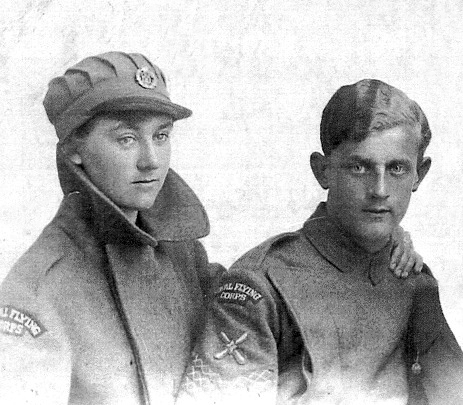
Brother and sister
– Bet and Billy Seabrook
As its name implies, the 1st Aeroplane Supply Depot (at Marquise
near Boulogne) was used as a park from which new aircraft were
supplied to squadrons and where repairs were carried out. On
the night of 23/24th September the Depot was attacked by 13 German
bombers in what would be the most devastating raid on a British
aviation facility during the War. It is estimated that some 12
tons of bombs were dropped on the Depot, killing 48 men and injuring
another 124. The damage to planes was also considerable with
26 destroyed, 73 damaged and spare parts (including aero engines)
and a number of aircraft hangars also being destroyed. I have
been unable to discover what types of planes were involved, but they
were probably of the AEG, Friedrichshafen and Gotha G-types, such as
that below.
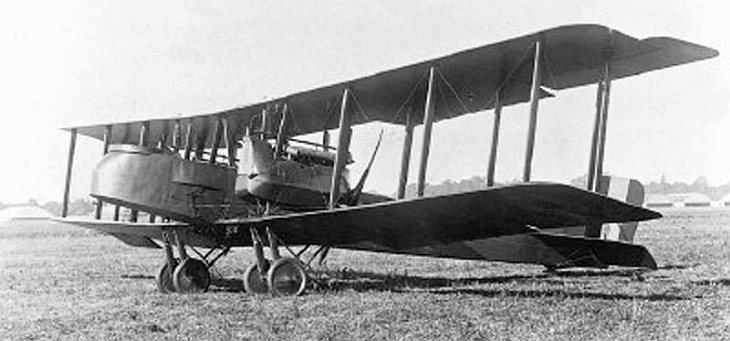
Gotha bomber
From the Bucks Herald 5th October 1918:
“Flight-Sergt. William Seabrook was
severely wounded in an enemy air-raid on Monday, Sept. 23, and died
two days later at a Canadian hospital at Boulogne, whither he was
conveyed at once for operation. A Sister at the hospital,
writing to his parents, said that the injuries were so serious that
recovery was impossible, and in a very brief period of consciousness
he asked her to inform his friends. Official notification of
his death has since been received from the War Office.
Sergt. Seabrook was 24 years of age, and the eldest son of Mr. and
Mrs. Charles Seabrook, 59, Western-road. He had completed
nearly four years’ service, joining up in the early months of the
war. For five years he was employed at the Napier Motor Works,
London, where he was held in very high esteem as a most capable
mechanic. At one time a member of the Y.M.C.A., Tring Branch,
he was one of the best-trained lads in the gymnastic troop, and took
part in many displays. His loss is felt deeply by his numerous
friends, and the sympathies of all go out to his parents and brother
and sisters in their bereavement.”
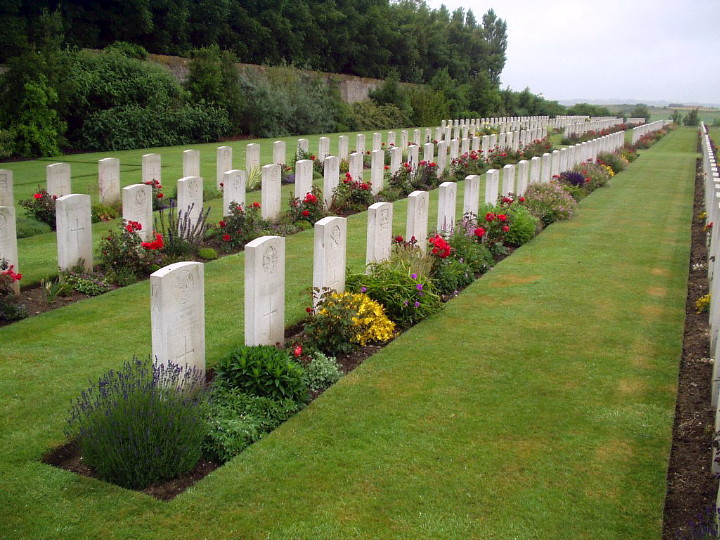
The first rest camps for Commonwealth forces were established near
Terlincthun in August 1914 and during the whole of the First World
War, Boulogne and Wimereux housed numerous hospitals and other
medical establishments.
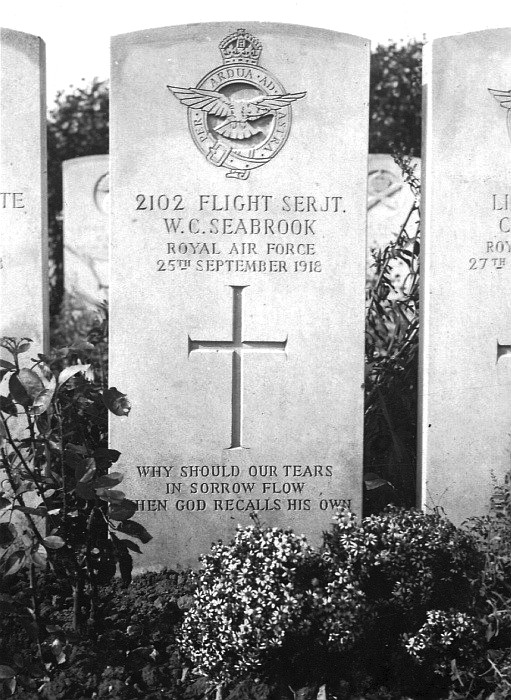
The cemetery at Terlincthun was begun in June 1918 when the space
available for service burials in the civil cemeteries of Boulogne
and Wimereux was exhausted. It was used chiefly for burials
from the base hospitals, but Plot IV Row C contains the graves of
46 RAF personnel killed at Marquise in September 1918 in a bombing
raid by German aircraft. In July 1920, the cemetery
contained more than 3,300 burials, but for many years Terlincthun
remained an ‘open’ cemetery and graves continued to be brought into
it from isolated sites and other burials grounds throughout France
where maintenance could not be assured.
During the Second World War, there was heavy fighting in the area in
1940. Wimille was devastated when, from 22-25th May, the
garrison at Boulogne fought a spirited delaying action covering the
withdrawal to Dunkirk. There was some fighting in Wimille
again in 1944. The cemetery suffered considerable damage both
from the shelling in 1940 and during the German occupation.
The cemetery now contains 4,378 Commonwealth burials of the First
World War and more than 200 war graves of other nationalities, most
of them German. Second World War burials number 149. The
cemetery was designed by Sir Herbert Baker.
――――♦――――
CHARLES EDWARD SPINKS
Lance Corporal, 7th Bedfordshire Regiment, service no. 43355.
Brother of Mrs. A. Charlton of Byker, Newcastle-on-Tyne.
Enlisted at Tring. Killed in action on the 11th January 1918
aged 22.
Buried in Artillery Wood Cemetery, Belgium, grave ref. XI. C. 2.
The 7th Battalion Bedfordshire Regiment [Note]
was formed at Bedford in September 1914, as part of ‘K2’, Lord
Kitchener’s 2nd call to arms for another 100,000 men to leave their
civilian lives and enlist into the rapidly expanding British Army. [Note]
The 7th battalion served entirely in France and Flanders between
their arrival in July 1915 and their disbandment in May 1918.
During this time they were involved in major battles every year of
their service, winning a well deserved reputation and numerous
gallantry medals including two Victoria Crosses.
In 1918 the 7th Battalion was heavily engaged in the First (1918)
Battles of the Somme − also called the German Spring Offensives [Note]
− namely in the Battle of St Quentin and the actions on the
Somme crossings in March, the Battle of the Avre in April, and the
action at Villers-Bretonneux on the 24th April 1918.
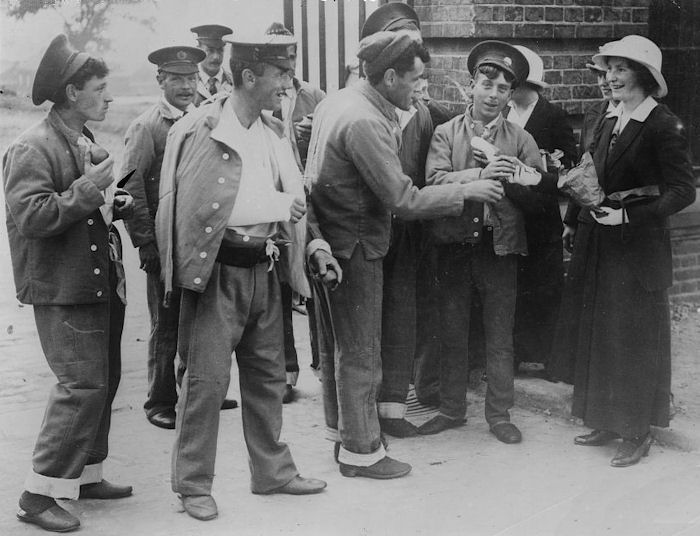
Bedfordshire Regiment wounded in
hospital uniform.
So far as I can gather, at the time of Lance-Corpl. Spink’s death
the 7th Battalion was at BABOON CAMP north of Ypres near the
Flanders village of Boesinghe (now Boezinge). During the war
the village was in the Ypres Salient, making it the site of the
battles fought there. Today there are memorials and war
cemeteries in the area, many of which are maintained by the
Commonwealth War Graves Commission. This from the 7th
Battalion’s War Diary: [Note]
“10-1-18 54th Brigade moved into the line
again in the HOUTHULST FOREST Sector in relief of 55th Inf. Bde.
BABOON CAMP 1 pm 7th Bedfords relieved 7th Buffs in BABOON CAMP.
11-1-18 C Coy. practised wiring. Weather very cold. 5 pm B & D Coys.
employed in carrying wiring material from KOKUIT DUMP to ADEN HOUSE
- casualties 1 Killed. 2nd Lt. E. J. Scott joined the
Bn. & posted to B Coy.”
and later . . . .
“CASUALTIES DECREASES The Commanding Officer
regrets to announce the following casualty. KILLED IN ACTION
43365 L/Cpl.Spinks, C. ‘B’ Coy. 11/1/18.”
From the Bucks Herald 26th January 1918:
“ROLL OF HONOUR.
− We have the deepest sympathy to record the death in action of yet
another promising young man belonging to the town, Lance-Corpl.
Charles E. Spinks of the 7th Beds Regiment. The sad news was
sent by a comrade, who states that Spinks was killed by a sniper’s
bullet when going on duty to the front line trenches on Jan. 11.
He was 21 years of age, and had seen just over two year’s service,
19 months of which was spent in France. He was the son of the
late Mr. H. and Mrs. Spinks, of Bunstrux Cottages, and before the
war was employed on the Home Farm of the Tring Park Estate, where he
was held in the highest esteem.
This is the second member of the family killed in the war, the older
brothers Sergt. W. Spinks, of the Herts Regiment, being killed in
action in September, 1916, and recommended for the D.C.M. for his
special gallantry.
The deepest sympathy is felt with the two sisters and young brother
of these two brave young fellow in this added weight of bereavement,
for during the war they have not only lost by death these two
brothers, but also both father and mother.”
From the Parish Magazine:
“L/CPL Charles Edward Spinks joined the
First Herts Regiment in November 1915, but when he went to France in
the following May, he was transferred to the Bedfords. One of
his Friends writing home says: ‘He was hit by a sniper’s bullet on
the night of January 11th and died almost immediately. I took
it to heart as much as if he had been my own brother, as we have
been together, practically for the last 18 months, side by side in
most of the big battles. It was hard lines for him, as he was
not warned for the trenches till the last five minutes. He was
buried in a cemetery in as good conditions as can be expected.’”
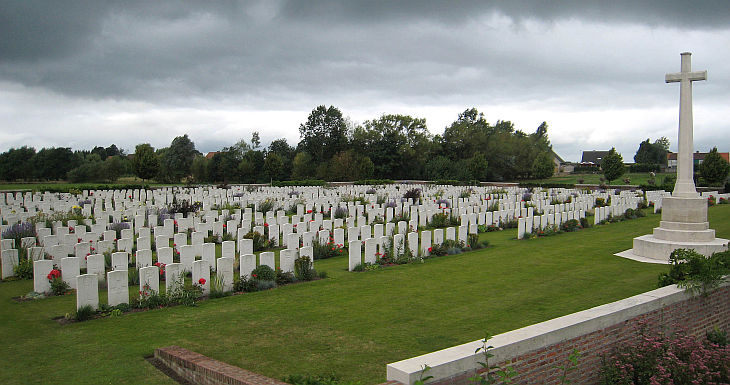
The Artillery Wood Cemetery was established in 1917 after fighting
in the immediate area – the Battle of Pilckem Ridge – had moved
away, and it was used for burials until March 1918. At the
Armistice there were some 141 graves in the cemetery, but
concentration from the battlefields and three smaller cemeteries (Boesinghe
Chateau Grounds, Brissein House and Captain’s Farm) enlarged this to
the present 1,307.
――――♦――――
WILLIAM GEORGE SPINKS, D.C.M.
Acting Sergeant, 1st Hertfordshire Regiment, service no. 1732.
Son of Harry George and Sarah Charlotte of Bunstrux Hill, Tring.
Killed in action at the Somme on the 26th September 1916 aged 25.
Buried in Auchonvillers Military Cemetery, France, grave ref. plot: II. I.
10.
From the Bucks Herald 22nd January 1916:
“HONOUR FOR A TRING MAN.
Local Lad Wins the D.C.M.
Corpl. W. Spinks, of the Herts
Territorials, whose name was in the Honours List published on the
14th inst., is at home on a short leave. He is the eldest son
of Mr. Henry Spinks, of Bunstrux Hill, Tring, and enlisted in the
Herts. Territorials at an early age. He is now only 21.
When he got home of the 16th, he received the first intimation that
he had been awarded the coveted distinction of D.C.M. He had
previously received the following letter from the Commanding Officer
of his Division: –
‘Your Commanding Officer and Brigade Commander have informed me
that you have distinguished yourself by conspicuous bravery in the
field, on Sept. 27th. I have read their reports, and, although
promotions and decorations cannot be given in every case, I should
like you to know that your gallant action is recognised, and how
greatly it is appreciated.
W. J. Horne,
Major-General, 2nd Division.’ *
Corpl. Spinks, who has been in France since
November, 1914, is very reticent as to the gallant action which
gained him his decoration, and it is not so much from his own modest
statement as from letters from admiring comrades that one is able to
glean particulars of his brave deed on the La Bassee frontier.
It seems that on Sept. 27th, two days after the Battle of Loos, the
Division was expecting orders to make an attack. There was a
special piece of work to be done, and Corpl. Spinks with two
volunteers, started off in broad daylight between the British and
German trenches to make certain observations. When they were
half way through the Germans opened fire upon them, but they kept on
till one of them fell wounded. Corpl. Spinks got the
information wanted, and starting back alone, amid continuous fire,
reached headquarters in safety with his report, which probably saved
the position.
Since he has been home, Corpl. Spinks and his parents have been the
recipients of hearty congratulations on all hands. The
Corporal’s leave expires on the 24th.”
* I can’t trace a Major-General W. J. Horne, but
the career of General Henry Sinclair Horne, 1st Baron Horne
GCB, KCMG (1861 – 1929) as he later became seems to fit the picture.
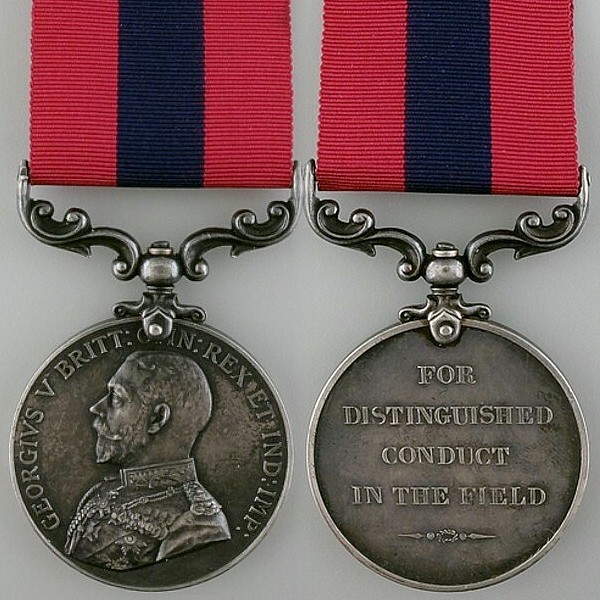
|
1732 L/Cpl. (A/Cpl) W. G.
SPINKS 1st Bn. TF
For conspicuous gallantry.
He had been ordered to make a difficult and dangerous
reconnaissance; he went over the parapet, the enemy
being only 50 yards distant, and firing heavily.
He returned, and his report saved a useless waste of
fire. |
From the Bucks Herald 7th October 1916:
“OUR ROLL OF HONOUR.
SERGT. SPINKS D.C.M.
We have to record the death of a promising young soldier, Sergt.
Spinks D.C.M., of the Herts. Regiment.
At the beginning of the year we had to chronicle the fact that Corpl.
Spinks had been awarded the D.C.M. for conspicuous bravery in the
field. He was promoted to the rank of sergeant, and was
greatly respected throughout the Battalion for his sterling
qualities as a soldier and a man. The news of his death was
conveyed to his father in a latter written by Corpl. Whitby, from ‘B.E.F.,
France.’ He says: –
‘DEAR MR.
SPINKS, – You will have heard from other
sources of the death of your son, Sergt. Spinks. I do not wish
to intrude upon your grief, but I cannot refrain from letting you
know how much he was admired and respected throughout the whole
Battalion. The platoon wish me to convey their sympathy with
you in your great bereavement, and to say that your loss is also
theirs. As you know, he had only been in charge of the platoon
for a very short period, but during that time we had learnt to have
great confidence in him. He was always cool, steady and
reliable – a fine Briton. He was killed by a German trench
mortar bomb yesterday evening, and death was instantaneous and
without suffering.’
Mr. Spinks has been informed that his son was buried in a little
military cemetery behind the lines, and that his grave will be cared
for.”
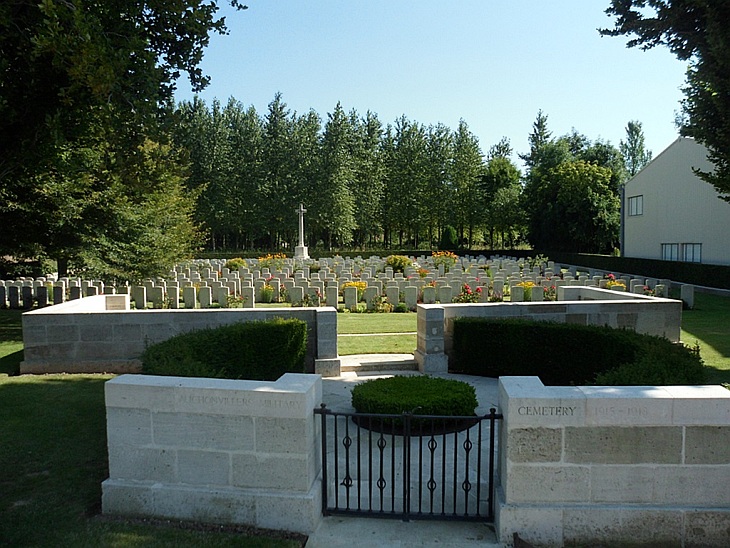
From the outbreak of the war to the summer of 1915, this part of the
front was held by French troops, who began the Auchonvillers
Military Cemetery in June 1915. It continued to be used by
Commonwealth field ambulances and fighting units, but burials
practically ceased with the German withdrawal in February 1917.
After the Armistice, 15 of the graves (Plot II, Row M, Graves 4-18)
were brought in from scattered positions east of the cemetery.
The cemetery now contains 528 Commonwealth burials of the First
World War, the French graves having been removed to other burial
grounds. Casualty Details: UK 496, Canada 8, New Zealand 24,
Total Burials: 528.
――――♦――――
CHARLES SIDNEY STEVENS
Private, 15th (Suffolk Yeomanry) Battalion Territorial Force. Enlisted at Bedford, service no.
51856.
Born in Aylesbury. Son of Mr. and Mrs. Stevens, 2a, Albert
Street, Tring.
Killed in action in Belgium on the 2nd November 1918.
Buried in Lamain Communal Cemetery, Hainaut, Belgium (near the far
end of the left part).
The 15th (Suffolk Yeomanry) Battalion was formed in Egypt on the 5th
January 1917 from dismounted Yeomanry regiment. [Note]
In January 1917 the Battalion came under command of 230th Brigade in
74th (Yeomanry) Division. [Note]
On the 1st May 1918 the Battalion embarked at Alexandria for
Marseilles, landing there on the 7th May after which it was engaged
in various actions on the Western Front [Note]
including The Second (1918) Battles of the Somme, The Battles of the
Hindenburg Line, The Final Advance in Artois and Flanders. [Note]
The Battalion ended the war at Tournai in Belgium.
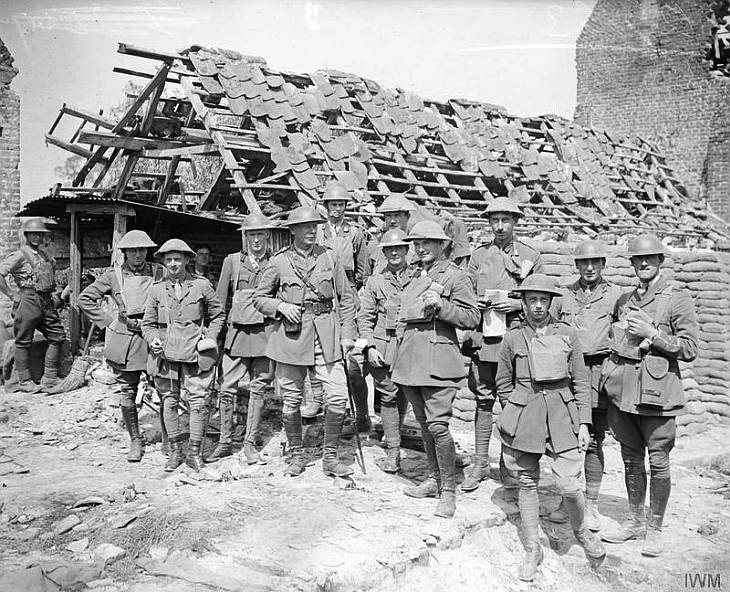
Headquarters officers of the 15th
(Suffolk Yeomanry) Battalion, near Carvin, 14th August 1918.
From the extracts below it appears that Private Stevens was killed
on the 2nd November during the German shelling of the Belgian city
of Louvain (Leuven). This
from the Bucks Herald 16th
November 1918:
“Pte. Charles Sidney Stevens, 3rd Suffolk
Regiment, son of Mr. and Mrs. Stevens, 2a, Albert Street, was 28,
and had served in the Army for over two years, but only proceeded to
France some nine weeks ago. Information was received from his
platoon officer on Thursday week that Stevens had been killed in
action at Louvain on Nov. 2nd.
Before joining the Army Stevens was employed at the Museum, and was
held in the highest esteem.”
From the Parish Magazine December 1918:
“Charles Sidney Stevens, Royal Suffolk
Regiment, was killed on November 2nd. He only went to France
in September, though he had been in the army for two and a half
years. For many years he was a member of our Church Lads
Brigade, and rose to be an instructor, and was among those who
worked hardest to make his company the most efficient in the
Diocese. His Lieutenant writing to Mr and Mrs Stevens, says:
‘He was killed early in the morning of 2nd November and injuries
were such that death was instantaneous. He was buried next
morning at a neighbouring cemetery by the Padre. You have my
deepest sympathy and I am more exasperated, because he fell a
victim of the Hun brutality in shelling villages which he knows are
occupied by civilians whom it is impossible to evacuate.
He is buried in the Belgian Communal Cemetery and a cross has been
erected over his grave.’”
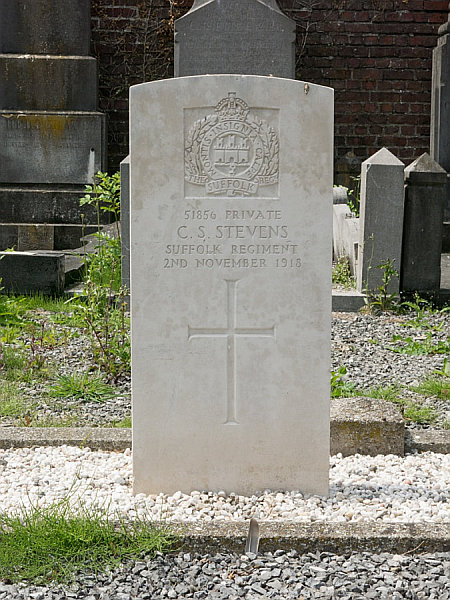
Lamain Communal Cemetery, Hainaut, Belgium, contains just eight
Commonwealth burials of the First World War, all men of the 74th
(Yeomanry) Division who died during the Advance to Victory in
October and November 1918.
――――♦――――
ARTHUR STRATFORD
Private, 5th Oxfordshire and Bucks Light Infantry, service no. 7686.
Born in Tring. Son of Elisha and Charlotte Stratford of 9 New
Mill Terrace.
Husband of Mrs. G. Stratford of 86 Cecil Road, Wealdstone,
Middlesex.
Enlisted at Houndslow, Middlesex. Killed in action on the 17th
October 1915 aged 30.
No known grave. Commemorated on Ypres (Menin Gate) Memorial,
Belgium, panels 37 and 39.
The 5th (Service) Battalion, Oxfordshire and Buckinghamshire Light
Infantry was raised at Oxford in August 1914 as part of Kitchener’s
First New Army [Note] and joined 42nd
Brigade, 14th (Light) Division. [Note]
After training they proceeded to France, landing at Boulogne on the
21st May 1915. They fought in the Action of Hooge – being the
first division to be attacked with flamethrowers (30th July 1915,
Note) –
and were in action in the Second Attack on Bellewaarde (25th
September 1915).
Private Stratford was believed killed in action in a German mine
explosion on the 17th October 1917. At that time the Battalion
was in the vicinity of Railway Wood, located a little north of Hooge
(a small Belgian village on the Bellewaerde Ridge east of Ypres).
The following extracts are from the 5th Ox & Bucks War Diary
[Note]
(I’ve inserted hash symbols where I can’t read a word and question
marks where I am unsure):
“Railway Wood trenches:
16.10.15: Quiet morning. Heavy fog early.
Unfortunately party of 5 men carrying knife rests [Note]
down the railway were caught by fog lifting & 2 were killed & 2
wounded.
Enemy fired Crumps & Whizz-bangs [types of German
artillery shells] into RAILWAY WOOD in the
afternoon & our guns retaliated.
Every available man in the Battn. worked (?) all night, as there is
a great deal of repairing and drainage to be done.
Casualties - killed ORs 2, wounded ORs 6.
17.10.15: 5.15am, enemy exploded mine
[Note]
under the junction of H20 & H21. Our mine shaft in H20 was
blown up. It appears to have been a defensive measure only as
no Art. fire was opened, & no attack made till later. The ###
trench at the junction of H20 & H21 was destroyed for about 4 bays
on either side of the junction. The earth was very much thrown
up round the lip of the crater, and runs in a long ridge to the
enemy crater of the 25th. Size of crater about 40 yds in diameter
and 30-40 ft deep.
7am. About 7am the enemy made 2 bomb attacks, one directed
against the crater, and the other against the SUNKEN ROAD.
Both were easily repulsed by our bombers & by rifle fire.
The behaviour of the men was excellent throughout, though for the
great majority of officers, N.C.O.s and men it was their first
experience of the trenches, there being only 3 officers, including
the Colonel and Adjt., who had been in the trenches before.
Immediately after the mine went up, the survivors in H20N, & in H20S
opened a very steady rapid fire, to which there was hardly any
reply: 2 platoons started work at once under 2nd Lt RODOCANACHI
[possibly Capt. Theodore Emmanuel (Michel) Rodocanachi,
DSO MC (1889-1983)] to dig out the men
buried in H20, and they succeeded in getting several out alive.
They continued the work through the bomb attack, & in spite of
severe ### fire by the enemy. Work was also started on wiring
between H20 & S20 & digging a trench round the crater. The
wiring was completed that night, & also a trench encircling half the
crater, with a bomb post & loophole at each ###: S20 was also
continued towards H21 to join up N of Crater.
2000 bombs were sent up by Brigade during the day, also 1 Coy 5/KSLI
(???) & 16 of their bombers. Battn. stood to arms all night.
Casualties, killed Captain R. O. LOGAN, 2nd Lt A.D.J. MELLISS, 13
O.R. missing; believed killed in the mine O.R. 22. Wounded O.R. 31.
18.10.15: Situation quiet, except for a lot of trench
mortaring & sniping. During last night an enemy M.G. north of
the railway continually ### our trenches with fire, especially those
in RAILWAY WOOD.”
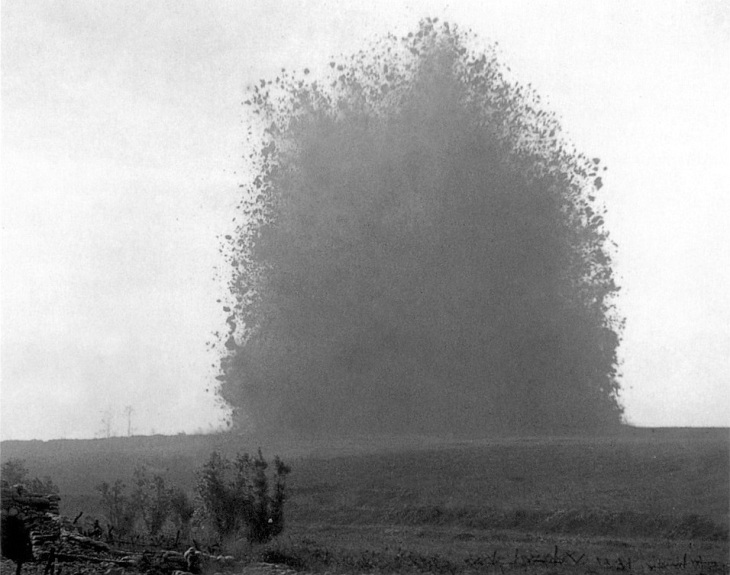
Mine exploding beneath Hawthorn Ridge
Redoubt on the Western Front, 1st July 1916.
Photo by Ernest Brooks.
From the Parish Magazine December 1915:
“Arthur Stratford a reservist serving in
the Oxford and Bucks Light Infantry, who has been reported as
missing since 17th October is now said to have been killed on that
day in a trench that was blown up by a German mine and has not been
seen since. He was wounded in one of the earlier battles of
the war, and sent to England. After eight months at home he
returned to France on 2nd October . He was 29 years of age.
We offer our deep sympathy to his friends.”

The Menin Gate Memorial to the Missing is a war memorial in Ypres,
Belgium, dedicated to the 54,896 British and Commonwealth soldiers
who were killed in the Ypres Salient of World War I and whose graves
are unknown. Broadly speaking, the Ypres Salient stretched
from Langemarck in the north to the northern edge in Ploegsteert
Wood in the south, but it varied in area and shape throughout the
war.
――――♦――――
FREDERICK TURVEY
Private, 9th Royal Dublin Fusiliers, service no. 40490.
Born in Chesham, Bucks, of Tabernacle Yard Tring.
Enlised at Tring, formerly with the Bedfordshire Regiment.
Killed in action on the 8th August 1917.
No known grave. Commemorated on the Ypres (Menin Gate)
Memorial, Belgium, panels 44 & 46.
The 9th Battalion, Royal Dublin Fusiliers, was raised in September
1914 as part of Kitchener’s Second New Army [Note]
and joined 49th Brigade, 16th (Irish) Division. [Note]
They trained at Buttevant, then moved to Ballyhooley in June 1915.
In September they crossed to England for final training at Blackdown.
In December 1915 the Division proceeded to France, landing at Le
Havre and then concentrating in the Bethune area. In 1916, at
the Battle of Hulluch (27th April) near Loos, the Battalion was
subject to a German gas attack in which it suffered heavy
casualties. It was in action on the Somme during the The
Battle of Guillemont (3rd–6th September) – in which the Division
captured the village – and The Battle of Ginchy (9th September).
During the Third Battles of Ypres (31st July–10th November 1917) the
Battalion fought at the The Battle of Messines (7th–14th June) and
The Battle of Langemark (16th–18th August).
The Battalion ceased to be an effective fighting unit following
heavy losses during Langemark, and on the 24th of October it was
amalgamated with the 8th Battalion to form 8/9th Battalion.
Following further heavy losses, in February 1918 the 8th/9th and the
10th Battalions were disbanded and their men transferred to the 1st
and 2nd Battalions.
Private Turvey was killed in action on the 8th August 1917,
presumably in the heavy German artillery bombardment that commenced
on the preceding day and extended into the 9th August. The
following extracts are from the 9th Battalion War Diary [Note]
covering the period (Brandhoek is a small hamlet in Belgium situated
between Ypres, Vlamertinge and Poperinge):
“BRANDHOEK AREA.
2.8.17 - 5.8.16. Battalion remained at TORONTO CAMP
till the 5th August 1917 when the Brigade moved to the VLAMERTINGHE
AREA No. 3.
7.8.17. The Battalion relieved the 8th(S) Bn. R.[oyal]
Dublin Fusiliers in the BLUE LINE, with Headquarters at WILDE WOOD.
The BLUE LINE was subjected to an intense bombardment during
the time the Battn. was in occupation, and suffered severe
casualties.
7.8.17 - 9.8.17. ‘C’ Coy commanded by 2/Lieut. J. J.
COYNE, suffered heavily. 2/Lieut. COYNE, 2/Lieut. F. DOWLING,
2/Lieut. W. A. HARTY being killed. 2/Lieut. J. McGRATH was the
only officer left in ‘C’ Coy and did valuable work in keeping the
Company together under the most distressing circumstances.
10.8.17 - 15.8.17. The Battalion was relieved on the
night of the 10th by two Companies of the 6th Bn. CONNAUGHT RANGERS,
and on relief proceeded to Camp in the VLAMERTINGHE AREA No.3. and
remained in this Area till the night of the 15th inst.
15.8.17 - 18.8.17. At 8pm the Battalion moved up to
the position of Assembly on the BLACK LINE. Companies reported
in position at 11-30 p.m. ZERO Hour for the attack was
notified at 4-45 a.m. 16.8.17. Previous to ZERO the enemy
opened on the BLACK LINE with 5.9s and heavies [i.e.
artillery] [Narrative report in pdf format -
Part 1
Part 2].
18.8.17. At 2.25 p.m. the Battalion entrained at VLAMERTINGHE
en route for WATOU No. ‘A’ Area and detraining at POPERINGHE marched
to Camp.” |
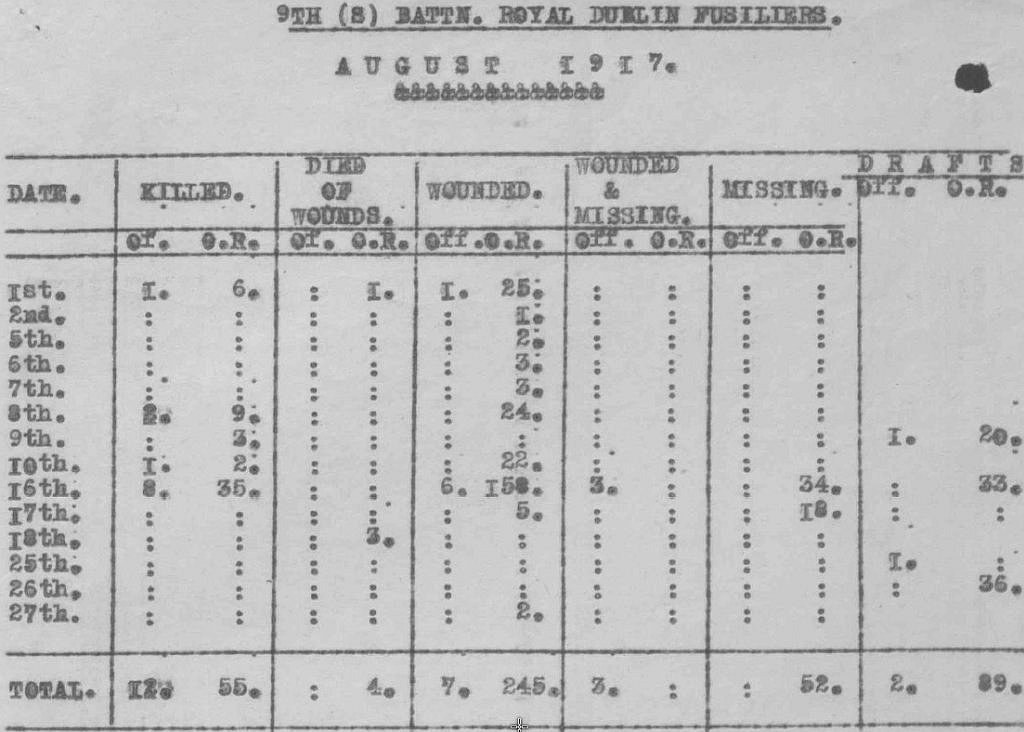
|
From the Bucks Herald 1st September 1917:
“Pte. Frederick Turvey, son of Mrs. John
Smith, Tabernacle Yard, is reported killed in action on August 8.
This gallant soldier was 27 years of age, and belonged to the Royal
Dublin Fusiliers, to which he was transferred from the Bedford
Regiment. He joined the Colours in February, 1915, having
previously been in the employ of Messrs. Prentice and Son, marine
store dealer.”
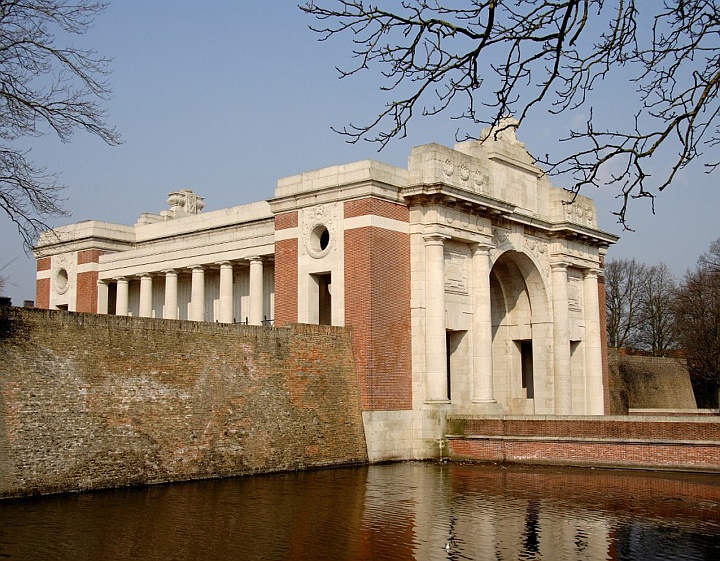
Exterior of the Ypres (Menin Gate)
Memorial.
The Menin Gate Memorial to the Missing is a war memorial in Ypres,
Belgium. The Memorial is located at the eastern exit of the
town and marks the starting point for one of the main roads out of
the town that led Allied soldiers to the front line. Its large
Hall of Memory contains the names on stone panels of 54,395 British
and Commonwealth soldiers who died in the Salient, but whose bodies
have never been identified or found.
Designed by Sir Reginald Blomfield and built and maintained by the
Commonwealth War Graves Commission, the Menin Gate Memorial was
unveiled on 24 July 1927.
――――♦――――
ALBERT JOHN TYLER
Private, 10th Duke of Cornwall’s Light Infantry, service no.
29788.
Born in Tring. Son of Clara Jane of 51 Wingrave Road, New
Mill, and the late Thomas Tyler.
Enlisted at Watford, formerly with the Surrey Regiment.
Killed in action in France on the 25th March 1918 aged 20.
No known grave. Commemorated on the Arras Memorial, France, bay 6.
The Duke of Cornwall’s Light Infantry (DCLI) was formed in 1881 when
the 32nd and 46th Regiments of Foot were amalgamated as part of the
Childers Reforms. [Note] The
newly formed Regiment [Note]
went on to serve during the Second Boer War (1899-1902) – fighting
at Paardeburg and Bloemfontein – and the two World Wars.
During the course of the Great War, the Regiment raised 16
Battalions, was awarded 57 Battle Honours and 1 Victoria Cross, and
lost 4,510 men.
In August 1914 the DCLI consisted of five battalions, 1st and 2nd
(Regular), 3rd (Special Reserve) and 4th and 5th (Territorial).
Apart from the 2/4th, which spent the war in India, all the newly
raised service battalions [Note]
served in France and Belgium. Two of them, the 1/5th and the
10th, became divisional pioneer battalions. [Note]
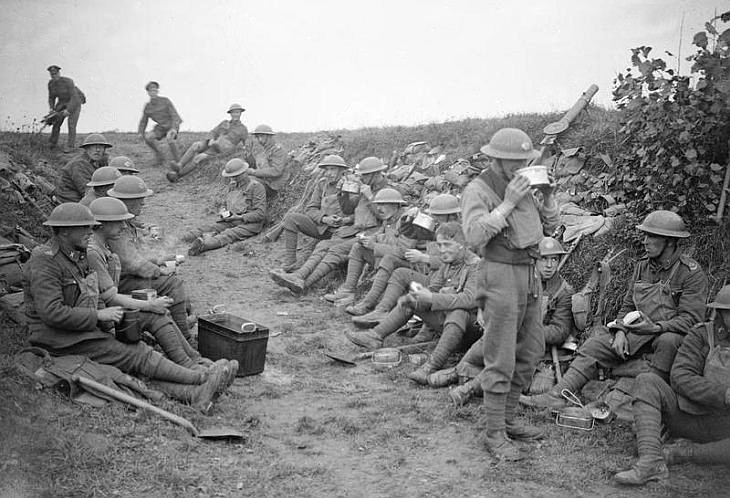
Troops of No. 1 Platoon, A Company, 10th
Battalion, DCLI near Le Quesnoy,
27th October 1918.
The German Spring Offensive [Note] –
designed to separate the French and British Armies and push the
British into the sea – commenced on the 21st March 1918.
Much of the ground fought over was the wilderness left by the Battle
of the Somme in 1916. Although the offensive was at first
spectacularly successful, with the Germans penetrating in places up
to 40 miles into Allied territory, it eventually ran out of steam
and was reversed. [Note]
Private Tyler was killed during the Offensive in what his sergeant,
writing to Tyler’s parents (see Parish Magazine below),
described as “this big retirement”, his euphemism for “retreat”.
Although in retreat, the Battalion War Diary [Note] for the day of
Private Tyler’s death describes heavy rearguard fighting (note that
the 10th Battalion were Pioneers, not trained as Infantry men):
25/3/18: platoon of ‘X’ Coy.
met a large force of the enemy face to face in the Sunken Rd. about
N7 c 1.7 and there was a real good scrap, both O.C. Coy. and Platoon
Officer were badly injured and three quarters of the platoon went
down but they wiped out the enemy to a man with the bayonet
[marginal note reads ‘estimate that they killed 50 Germans.’]
Owing to this unfortunate occurrence there was a gap and by
referring to the map it will be seen that it was exceedingly
dangerous as the enemy could approach the left rear down the valley
of which we had no observation. There were no reserves at all
as the line was too long for the number of men already, so it was
decided to send every Signaller, Officers’ servants, 2 Sgt.
Instructors and half the runners to fill the gap. Touch was
then established with the 1/4th Shrops L.I. 19th Divn. and the
position saved. This happened about 9am.
10.30am: about 10.30am the enemy had received
reinforcements and luckily for us the 1st. K.R.R. Corps
[King’s Royal Rifle Corps.?] came up and in
consultation with their C.O. it was decided that they should cover
the general retirement by manning the high ground in M23 central, as
the 63rd Division on our right were retiring thus leaving our flank
in the air. This was done and the firing line retired to the
same position, the left flank being in touch with the 19th Division
who had fallen back a little further in order to have a better field
of fire. The volume of fire from M23 central seemed to make
the enemy somewhat shy of taking risks and he consequently came on
very slowly. When the enemy had advanced to within 300 yds of
our line it was found that our right flank was again in the air so
it was decided to retire to the ridge in M15 & 20, leaving
rearguards of DCLI in LE SARS under 2nd. Lt. A. A. R. OXFORD.
This rearguard did very well indeed and allowed the main body to
take up their new positions unmolested and to distribute S.A.A.
[small arms ammunition], the
shortage of which had now become acute and it was only by everyone
looking out for abandoned clips that the situation improved
considerably. This position was not held long as the enemy
M.G.s fire on the high ground in LE SARS was very well directed,
also the fact was that the 19th Divn. on our left were again
retiring before we were ready to; possibly they were hard pressed.
Two points are worth noting here; first, the enemy used a cavalry
patrol on the LE BARQUE-EAUCOURT ABBAYE Rd. which was promptly and
efficiently dealt with by a Lewis Gun [Note] team of this Battalion;
Secondly, about this time all O.C. Coys. [officers
commanding companies] were lost and it is
certain that the casualties to officers were greatly caused by the
insufficient experience of N.C.O.s and men of what to do; on one
particular occasion a signal was given and the N.C.O.s and men did
not know how to act on the signal. It is a great pity that the
Battalion had not been given training, as when in extremity
Pioneer Battalions are called up to do infantry work.
2p.m.: The Bn. crossed DYKE Rd. about 2p.m. (All were
fighting on empty stomachs except for Iron Rations, which most had
not had time to eat) and took up a very good position on the high
ground in Sqs. M13 & 14. It was at this point that news came
that the rearguard 10th DCLI, 1st KRR and small party of Royal
Berks. were to go through the 5th and 6th. Inf. Bdes. who would take
up the fight. S.A.A. was finished, men were tired, thirsty and
hungry, no water was available and the above news bucked us up
considerably. During the whole of these operations up to this
point, close relationship had been kept with the C.O. 1st KRRs.
The trained Infantry men of this Corps gave considerable moral as
well as physical support to men of this Bn. who as was only natural
lacked the necessary experience.
The Battalion was formed up into Artillery formation in Sq. 57###
R60 [?] and proceeded according
to orders to concentrate at BEAUMONT HAMEL. An impression had
arisen at this time that we were out of danger and that new troops
were covering us; this inclined the men to straggle somewhat and
lack of definite instructions made it very hard for Senior
Regimental officers to make arrangements or to look ahead. At
this point, however, all were brought to their senses by G.S.O. 3
meeting the Commanding Officer and saying that the Battalion, and
also several other units would man the high ground about 57C Q12 &
facing S.E., this position to be held for 6 hours only when the
Battalion would be relieved. Eventually this ridge would be
manned, the men dug fire steps and made the trench ready to receive
the enemy. The Battn. was under the 99th Inf. Bde. in this
Sector. Hot food was provided for the men which put a
different complexion on life. Rations were also delivered,
thus making the men a fighting force again. The night was
spent in this position and was without exception the coldest night
for three years. Two patrols were out but found no sign of the
enemy.
The casualties listed in the 10th Battalion War Diary for the
25th March 1918 were: officers, 1 killed; 7 wounded. O.R.s, 14
killed, 76 wounded, 19 missing.
From the Bucks Herald 27th April 1918:
“THE ROLL
OF HONOUR.–The absence of definite news
from the Front has caused much anxiety amongst the relatives of
Tring men who are known to have been in the last great German
attack, and it is pleasing to hear that letters and cards have been
received telling of safety.
It is feared, however, that some of the men have yielded their
lives, whilst of others tidings are anxiously awaited. Albert
John Tyler, D. of C. Light Infantry, of New Mill, formerly employed
by Messrs. Glover and Sons, grocers, has been reported killed . . .
. ”
From the Parish Magazine:
“Albert John Tyler, the Duke of Cornwall’s
Light Infantry was killed in France on March 25th 1918. He
enlisted in the Royal West Surrey Regiment in November 1916, but on
being sent to France in December 1917, he was transferred to the
D.C.L.I. His Sergeant, writing on behalf of himself, the
N.C.O’s and men, says ‘I have to break to you, the sad news, that
your son was killed in action, while in this big retirement. I
did my best for him, and stopped with him until his life went.
He was by my side, when he got hit by a bullet in his back. I
am sorry to have to lose such a good fellow, for he was always
willing to do anything in his platoon. He fought well to the
last, for his King and Country, and we all wish to express our
deepest sympathy with you in the loss of your son.’”

At the entrance to the Faubourg d’Amiens Cemetery in France stands
the Arras Memorial. The Memorial commemorates nearly 35,000
soldiers of the British, South African and New Zealand forces with
no known grave. Most of those commemorated were killed in the
Battle of Arras, fought between the 9th April and the 16th May 1917,
and in the German Spring Offensive fought between the 21st March and
the 18th July 1918.
Designed by Sir Edwin Lutyens, the Memorial includes sculpture by
Sir William Reid Dick.
――――♦――――
ROLAND MADDISON VAISEY
Captain, 36th Royal Field Artillery.
Son of Arthur William and Esther. Husband of Violet Vaisey of
‘The Bungalow’, Tring.
Killed in action in France on the 7th September 1918 aged 31.
Buried in Vaulx Hill Cemetery, France, grave ref. II. H. 1.
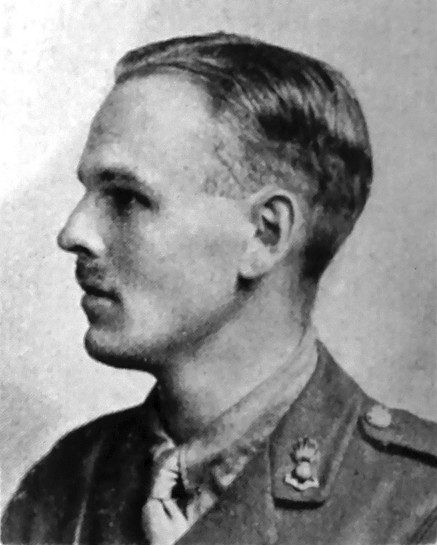
Captain R. M. Vaisey
From the Bucks Herald 14th October 1911:
“MARRIAGE OF MR.
R. M. VAISEY.
A wedding of more then usual interest to
residents in this part of the country was solemnised at the Parish
Church of St. Mary the Virgin, Shenfield, Essex, on Saturday.
The bridegroom was Mr. Roland Maddison Vaisey, second son of Mr. A.
W. Vaisey, solicitor, of Tring, who, as Clerk of the Tring Urban
District Council, the Berkhamsted Board of Guardians, the Governors
of Berkhamsted Grammar Schools, and Churchwarden of Tring Parish
Council, is so prominently associated with the civil and
ecclesiastical life of the district.
Mr. R. M. Vaisey, who has recently been taken into partnership by
his father, has for some time been actively interested in the work
of the various appointments held by Mr. A. W. Vaisey, and having
lived all his life in the town, is well known and very popular in
and around Tring.
The bride was Miss Violet Landon, second daughter of Mr. Harcourt
Palmer Landon, of The Lodge, Shenfield. Mr. Vaisey’s elder brother,
Mr. H. B. Vaisey, married some few years ago the only daughter of
the Rev. Canon Quennell, formerly Rector of Shenfield, and so his
family are already associated with the parish where the bride’s
father is churchwarden.
The church, which had effectively been decorated, was crowded for
the happy event, the congregation including, in addition to
relatives of the bride and bridegroom, several prominent residents
of Tring. From the lych gate to the entrance an awning had
been erected, and a carpet laid for the bridal procession . . . .
The bride wore a beautiful dress of ivory white satin trimmed with
duchesse lace, given by Mr. and Mrs. C. P. Martin. Her veil was the
one worn by her mother, and she also wore a wreath of orange blossom
and carried a magnificent bouquet of white carnations, white heather
and orange blossom. Her chief ornaments were a diamond and pearl
pendant, the gift of her Uncle, Mr. W. M. Munro, and a diamond paste
buckle, the gift of Miss McLeod . . . . ”
The 36th Brigade, Royal Field Artillery, [Note]
was originally formed with 15th, 48th and 71st Batteries, and
attached to 2nd Infantry Division. [Note]
On the 4th August 1914 the Brigade mobilised at Aldershot and was
brought up to strength with reservists and drafts from other units;
an Ammunition Column was also formed. the Brigade was sent to the
Continent with the British Expeditionary Force, [Note]
disembarking at Boulogne the 19th August 1914, thereafter serving
with 2nd Division throughout the war. A howitzer battery was formed
in May 1916 from a section of each of 47th (Howitzer) and 56th
(Howitzer) Batteries, and designated ‘D’ Battery.
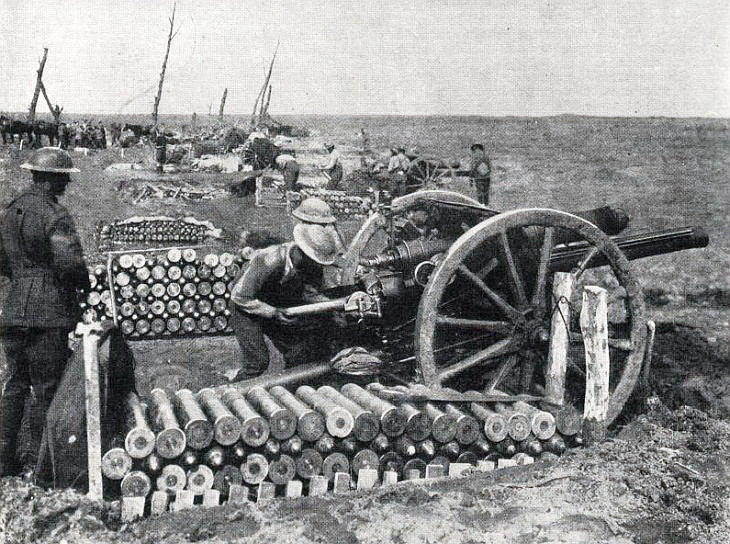
The 18-pounder was the main British
field gun during the First World War,
forming the backbone of the RFA.
Captain Vaisey was killed in action during the Hundred Days
Offensive [Note], the 36th
Brigade RFA at the time being in the vicinity of Vaulx-Vraucourt, a
village in the Hauts-de-France region of France. The village
was taken in the spring of 1917, lost after severe fighting in March
1918, [Note] and retaken in the
following September.
During the night of the 7th September the 99th Infantry Brigade
Headquarters, located in a dugout on the Doignies-Demicourt road,
came under bombardment. The brigade transport was passing at
the time and, among others, Captain Vaisey had the misfortune to be
caught up in the shelling and killed. Other than recording his
death, the rather sketchy 36th Brigade War Diary [Note]
does not refer to the incident:
“VAULX-VRAUCOURT.
1918.
Sept. 1st. The enemy still holding onto N & E edges of VAULX.
Batteries moved up into action behind VRAUCOURT during the morning.
Afternoon passed quietly but Boche bombers very active during the
night on roads in vicinity of batteries.
Sept. 2nd. 2nd Div. attacked at 5.30am intending to push on to MORCHIES – partly successful, reaching VAULX COPSE & MARICOURT WOOD.
Enemy M.G.s offered stubborn resistance.
Sept. 3rd. Batteries fired barrage to take MORCHIES. Infantry found
no enemy & pushed through MORCHIES, BEAUMETZ-LEZ-CAMBRAI, & DOIGNIES,
meeting no resistance till the DEMICOURT-HERMIES line. Brigade
concentrated in I4 & remained in reserve remainder of day and
following night.
BOURSIES
Sept. 4th. Batteries went into action in valleys south of BOURSIES.
Sept. 5th. Infantry pushed on towards Canal [probably the
Canal du Nord] bank & took the SLAG HEAP
but were forced to evacuate it owing to M.G. fire.
Sept. 6th. Quiet.
Sept. 7th. Capt. R. M. Vaisey - adjutant - instantaneously killed
by a shell.
Sept. 7th - 10th. Quiet.”
From the Bucks Herald 21st September 1918:
“CAPTAIN R. M. VAISEY.
Captain Roland Madison Vaisey, R.F.A., who was killed in action
instantaneously on Septemver 7, was the younger son of Mr. and Mrs.
Arthur Vaisey, of Tring, and was born on Dec. 31, 1886. He was
educated at Shrewsbur, admitted a solicitor in 1909, and practised
with his father. Obtaining his commission in July, 1916, he
immediately afterwards went to France, where he served continuously
until his death.
His Colonel writes:– ‘He has been my Adjutant now for over a year,
and has been a wonderfully good and efficient one, and more than
that, he has been a very great personal friend and companion.
He will be a very great loss to me and all my brigade, in which he
was universally liked and respected.’
Captain Vaisey married on October 7, 1911, Violet, daughter of Mr.
and Mrs. Harcourt P. Landon of Shenfield, and his widow, a son, and
two daughters survive him.”
From the Church Magazine:
“On 7th September (the anniversary of his
parent’s wedding) Captain and Adjutant Roland Maddison Vaisey R.F.A
was instantly killed in action by an enemy shell.
Possessing great physical strength and fond of outdoor pursuits he
entered whole heartedly into the life of the Army and having also,
(though he always disclaimed it) a gift of superb courage, he had
come serene and cheerful through some of the hardest fighting of the
war. His fine and manly character and lovable disposition will long
be remembered in the town of his birth where a useful career seemed
to lie before him.
To his wife, and to his father, mother, brother and sisters our
sympathy has gone out in full measure; they speak of with grateful
hearts of the strong ties of love by which he was bound by them;
they know that he lived and died in the true faith of a Christian
man. He leaves for them, for his children, and for all of us, a good
record of duty well and simply done.”

Vaulx Hill Cemetery was started with just 17 graves of September
1918 (in Plot I, Rows A and B). The rest of the cemetery was
formed after the Armistice when graves were brought in from the
battlefields in the immediate neighbourhood and the following
smaller cemeteries. The cemetery now contains 856 Commonwealth
burials and commemorations of the First World War. 258 of the
burials are unidentified but special memorials commemorate 29
casualties known or believed to be buried among them, and four
others buried in other cemeteries whose graves were destroyed by
shell fire.
――――♦――――
ARTHUR WELLS
Stoker 1st Class, HMS Aboukir, Royal Navy, service no. 24578.
Killed in action (lost at sea) on the 22nd September 1914 aged 28.
Born on the 29th May 1886 in Tring, Hertfordshire.
Husband of Mrs. A Wells, of 40 Sheldon Road, Silver Street,
Edmonton, London N.
No known grave. Commemorated on Chatham Naval Memorial (6),
Kent.
The incident in which Arthur Wells lost his life took place before
the Royal Navy had fully woken up to the risk posed by submarine
attack. The loss of 3 cruisers and many lives in a single
incident caused outrage in the country and damaged the Royal Navy’s
reputation.
On the morning of the 22nd September 1914, the three elderly
cruisers Aboukir, Hogue and Cressy were patrolling at 10 knots in
line abreast. The German submarine U-9 had been forced to dive
and shelter from a storm. On surfacing, she spotted the
British warships and positioned herself for an attack. At
06:20, the submarine fired a torpedo that struck Aboukir on the
starboard side, flooding her engine room and bringing the ship to a
standstill. As no submarine had been sighted, the Aboukir’s
captain assumed that she had struck a mine and ordered the other two
cruisers to close in to help. After 25 minutes Aboukir
capsized, and then sank five minutes later. Her two sister
ships closed in to rescue, whereupon Hogue was torpedoed followed
soon after by Cressy. By 7.55 the three ships lay beneath the
waves together with many of their crews.
|
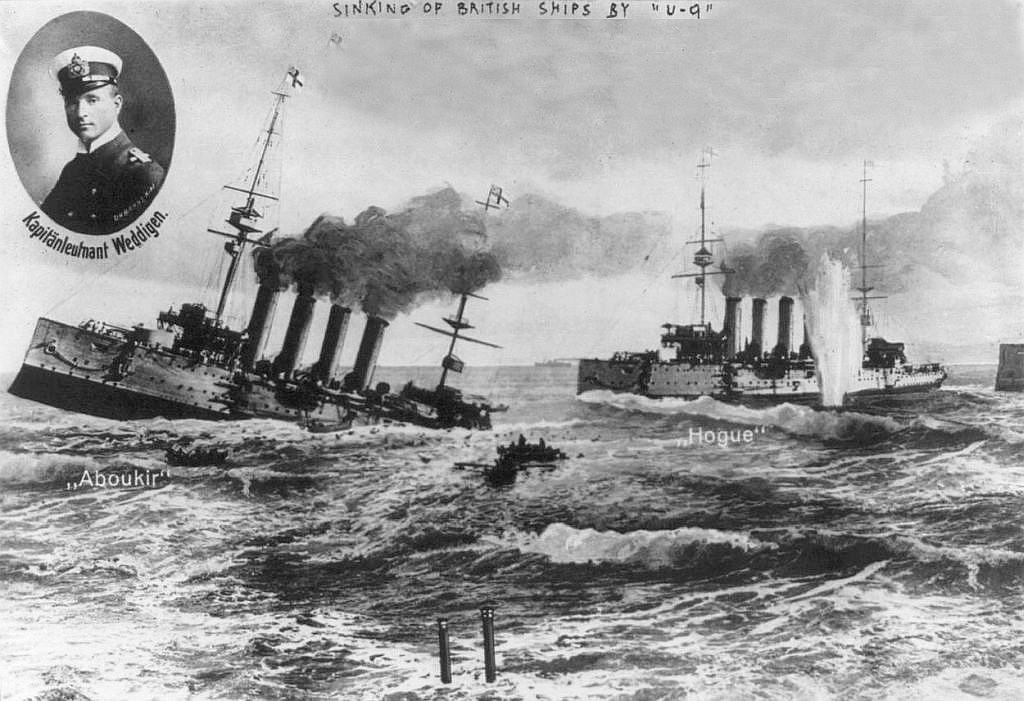
“Victories of U-9” — a contemporary German postcard
showing the sinking Aboukir and Hogue
with the photo of the submarine’s commander, Otto Weddigen, in the
corner.
|
Soon after the Dutch (neutral) steamship Flora approached the scene
and rescued 286 men. A second steamer, the Titan, picked up
another 147, and more were rescued by two Lowestoft sailing trawlers
before Royal Naval destroyers arrived on the scene. In total
837 men were rescued while 1,397 men and 62 officers perished.
The submarine commander, Otto Weddigen, died while commanding U-29.
On the 18th March 1915, U-29 was rammed by the British battleship
HMS Dreadnought in the Pentland Firth. She had broken surface
immediately ahead of Dreadnought after firing a torpedo at HMS
Neptune, and Dreadnought cut the submarine in two after a short
chase. There were no survivors.
From the Parish Magazine November 1914:
“The first name of anyone from Tring who
has given his life for his country, and therefore, will always find
a place in our Roll of Honour is that of Arthur Wells, Stoker, R.N.
Reserve. He was probably on duty below on that fatal 21st of
September, when H.M.S. Aboukir was torpedoed by the German submarine
in the north sea. R.I.P.
We offer his wife, who will now return to her mother’s home in
Albert Street, and his parents (of Tring Ford) who have three other
sons on active service, and two more serving on merchant ships, our
very sincere sympathy.”
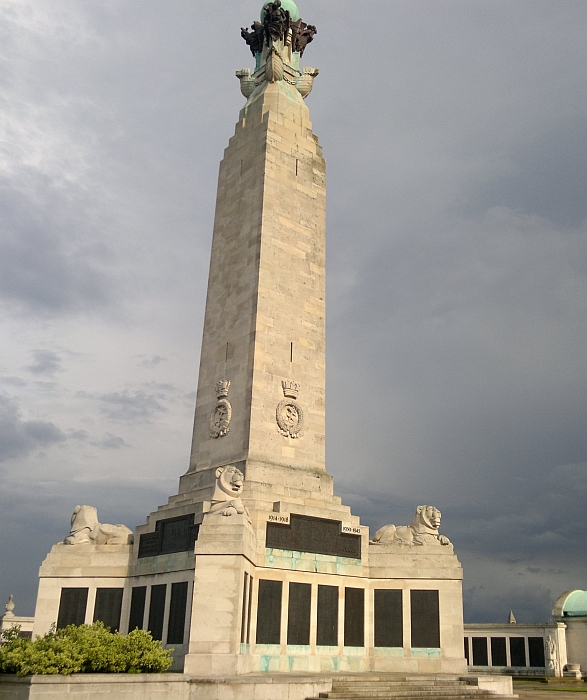
Chatham was a principal manning port of the Royal Navy during the
First World War and thus was dedicated as the site of one of three
memorials to sailors, airmen and marines of the Royal Navy.
The Chatham Naval Memorial is made of Portland stone with bronze
plaques. Unveiled on the 26th April 1924 by the Prince of
Wales, it commemorates more than 8,500 Royal Navy personnel of the
First World War who have no known grave and over 10,000 of the
Second World War who were lost or buried at sea.
――――♦――――
ARTHUR FRANK WELLS
Private, 74th Royal Army Ordnance Corps, service no. 24578.
Husband of Lillie of 31 Albert Street, Tring.
Died of
pneumonia/influenza on the 19th February 1919 aged 40.
Buried in Blargies Communal Cemetery Extension, France, grave ref. I. G. 1.
Private Wells was not (unless an extreme situation required it) a
fighting soldier. As a member of the Royal Army Ordnance Corps
he was attached to the branch of the Army that handled both supply
and repair. In the supply area the RAOC was responsible for
weapons, armoured vehicles and other military equipment, ammunition
and clothing (Private Wells was a tailor), and certain minor
functions such as laundry, mobile baths and photography. The
Corps was also responsible for a major element of the repair of Army
equipment.
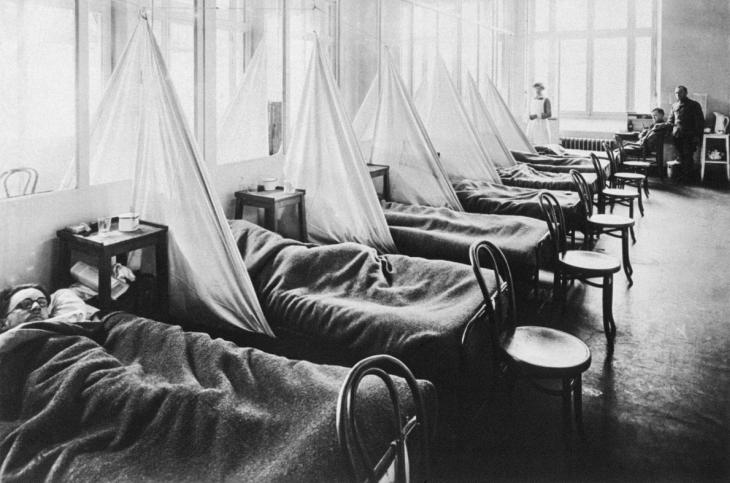
Patients lie in an influenza ward at a
U.S. Army camp hospital in Aix-les-Baines, France,
during World War I.
However, the enemy that Private Wells encountered and succumbed to,
Spanish Flue, was in every way as deadly as a German bullet or
artillery shell. [Note]
From the Bucks Herald 1st March 1919:
“Frank Wells, of Albert-street, was carried
off, after an attack of [Spanish]
influenza, somewhat suddenly at a hospital in France. The sad
news caused general regret, Mr. Wells being held in the highest
esteem and a much respected Deacon of High-street Church. He
leaves a widow and three children, with whom the deepest sympathy is
felt in their great loss. He was buried in Blargies Cemetery
on the day following his decease.”
From the Parish Magazine Easter 1919:
“Arthur Frank Wells, died from pneumonia
following influenza. He joined up in November 1916, and
crossed the channel in the following month. He worked at his
trade, and was regimental tailor. His Captain, writing to his
wife, says: ‘Your husband was well liked, and his death came as a
very great shock to us all. He was only in hospital for a few
days. He was buried yesterday, and his funeral was attended by
myself and several of his comrades and a wreath was place on his
grave.’”
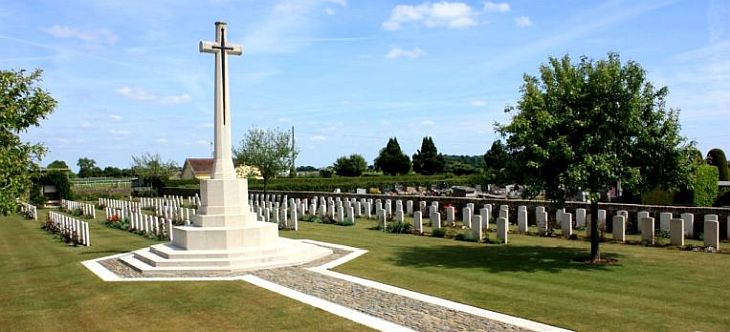
In 1916 Blargies became an important centre of British and native
labour attached to the dumps and depots at Abancourt; and in the
same year it was found necessary to open an Extension of the
Communal Cemetery for the burial of men who died in the hospitals of
the Camp. The Extension was used until 1920. There are
now nearly 250, 1914-18 and a small number of 1939-45 war casualties
commemorated in this site.
――――♦――――
JOSEPH WEST
Private, 7th Royal West Kent Regiment, service no. 205506.
Son of Martha West of 19 Albert Street, Tring.
Died of wounds on the 12th June 1918 aged 31.
Annois Communal Cemetery, France, grave ref. plot 1, row B, grave 2.
The 7th (Service) Battalion, [Note]
Royal West Kent Regiment was raised at Maidstone on the 5th of
September 1914 as part of Kitchener’s Second New Army [Note]
and joined 55th Brigade, 18th (Eastern) Division. [Note]
After initial training near home, in April 1915 they moved to
Colchester and then, in May, to Salisbury Plain for Final training.
On the 27th of July 1915 the Battalion landed at Le Havre, their
Division concentrating near Flesselles.
In 1916 they were in action on The Somme [Note]
in The Battle of Albert capturing their objectives near Montauban;
The Battle of Bazentin Ridge (including the capture of Trones Wood);
The Battle of Delville Wood; The Battle of Thiepval Ridge; The
Battle of the Ancre Heights (in which they took part in the capture
of the Schwaben Redoubt and the Regina Trench); and The Battle of
the Ancre.
In 1917 they took part in the Operations on the Ancre including
Miraumont and the capture of Irles. They fought during The
German retreat to the Hindenburg Line [Note]
and in The Third Battle of the Scarpe before moving to Flanders
where they were in action in The Battle of Pilkem Ridge; The Battle
of Langemarck; and The First and Second Battle of Passchendaele.
In February 1918 they transferred to 53rd Brigade still with 18th
(Eastern) Division. They saw action during The Battle of St
Quentin; The Battle of the Avre; The actions of Villers-Brettoneux;
The Battle of Amiens and The Battle of Albert, where the Division
captured the Tara and Usna hills near La Boisselle and once again
captured Trones Wood. They fought in The Second Battle of Bapaume;
The Battle of Epehy; The Battle of the St Quentin Canal; The Battle
of the Selle and The Battle of the Sambre. [Note]
At the Armistice (11th November 1918) the Division was in XIII Corps
Reserve near Le Cateau and demobilisation began on the 10th of
December 1918.
The note from the Parish Magazine below states that private
West was captured – apparently wounded – in March 1918, which
suggests that he was taken prisoner early in the German Spring
Offensive. [Note] In this
context the Battalion War Diary [Note] for the first part of
March contains nothing of note, but from the 20th March onwards it makes alarming reading, describing clearly the Allied
retreat in the face of Ludendorff’s sudden and overwhelming offensive:
“LY FONTAINE
19.3.18. Enemy aeroplane forced down in our lines at
about 6.45 am. Pilot was taken prisoner and sent to Bde. HQ under
escort.
Battalion relived 10th Battn Essex Rgt in Southern subsector of
Northern Sector of 18th Divisional front, night of 19th/20th. Lieut.
Col. J. D. CROSTHWAITE M.C. assumed command of Battalion, vice Lt.
Col. C. H. L. CINNAMOND.
IN THE LINE
20.3.18. Battalion holding line near MOY, “Standing
to”. Information received that enemy was massing in large numbers.
21.3.18. Under cover of dense mist enemy
advanced & surrounded Battn. HQ at about 11am. ‘A’ ‘B’ and ‘C’ Coys were also surrounded at about 10.30 am. Capt A. V.
McDonald M.C. 2nd in command was sent to Brigade HQ at about 9am.
From there he gathered remnants of Battalion, and all available
reinforcements (which had been sent from ‘Details’ at FRIERES CAMP),
and took over Command. Battn. gradually withdrew to FAILLOUEL
and held BLUE LINE just West of Canal. Approximate casualties
– 20 officers & 577 OR. In addition, personnel from 18th Div
Wing III Corps RTC [possibly related to training] had been sent to
various parts of the front, together with personnel from courses
etc. The greater portion of these also became casualties.
22.3.18. Battn. withdrew to former Divn HQ at
ROUEZ during night 22nd/23rd.
ROUEZ
23.3.18. In Divisional Reserve.
IN THE LINE
Fell back in
evening on VILLEQUIER AUMONT, taking up line running just WEST of
CHAUNY, joining up with 9th Cuirassiers a #### in the Village (2
casualties).
23/24.3.18. Withdrew to COMMENCHON.
24/25.3.18. Held CREPIGNY line but fell back at midday
on MONDESCOURT, holding hill West of Village. Then fell back
behind BABOEUF (8 Casualties on 24th) (37 Casualties on 25th).
25/26.3.18. During night fell back on PONT OISE &
billeted for night.
26.3.18. At 10 am moved to CAISNES. Rested there till
5pm; then moved to NAMPCEL where night was spent.
27.3.18. At 4pm moved from NAMPCEL via AUTRECHES to
MANTEBRAY where Details and Transport joined at 7.30pm.
MANTEBRAY
28.3.18. Resting and cleaning up.
29.3.19. At 4am Battn. moved off & boarded lorries at
6.30am. Proceeded to BOVES, arriving at 6.30am 30th.
30.3.18. Marched at once to GENTELLES & immediately
took over Corps Reserve Line just beyond Village. Battn.
returned to billets at 9pm.
31.3.18. At 12.30 am moved off to take over Support
Line at HANGARD. Received advice of about 500 Reinforcements from
12th Entrenching Batt.”
And so ended March 1918, the Battalion by then having an
extraordinary number of officers – including the Battalion
commanding officer, Lieut. Col. J. D. Crosthwaite M.C. – posted “missing”
(other ranks are not detailed). |
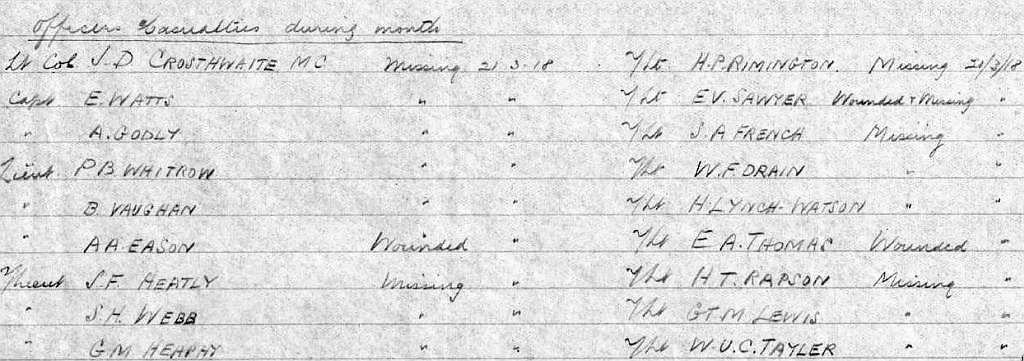
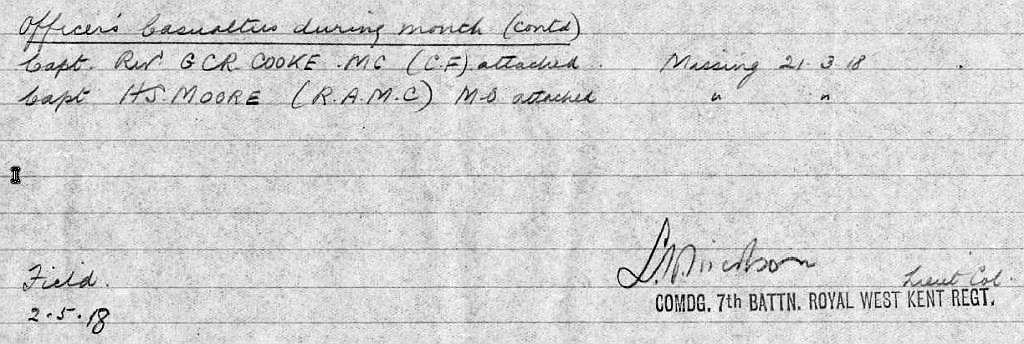
|
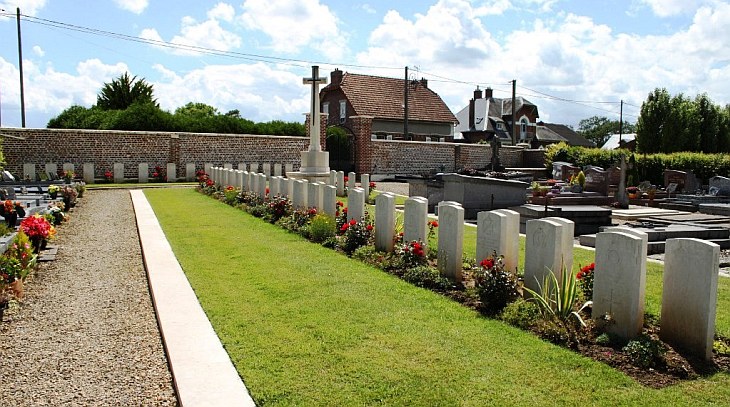
In May and June, 1918, a German field hospital for prisoners was at
Flavy-le-Martel, and soldiers from the United Kingdom who died in
the hospital were buried in Annois Communal Cemetery. There
are now over 60, 1914-18 war casualties commemorated in this site.
The two plots cover an area of 253 square metres and are enclosed by
stone curbs.
――――♦――――
ARTHUR WILKINS
Rifleman, 10th Battalion Rifle Brigade, service no. S/10834.
Son of Mrs. M.
Wilkins of 4 Western Road, Tring.
Killed in action on the 3rd September 1916 aged 20.
No known grave. Commemorated on the Thiepval Memorial, France,
pier and
face 16 B and 16 C.
The 10th (Service) [Note] Battalion
10th (Service) Battalion was formed at Winchester in September 1914
as part of K2. [Note] Following training,
in July 1915 it landed at Boulogne as part of the 59th Brigade in
the 20th (Light) Division [Note]
for service on the Western Front. [Note]
During 1916, the Battalion saw action at the Battle of Mont Sorrel,
The Battle of Delville Wood and The Battle of Guillemont, the latter
being the action in which Rifleman Wilkins was killed on the 3rd
September.
Progress on the eastern flank of the British line was essential if
the French and British were to cooperate properly north of the
Somme. [Note] By the start of
September the capture of Guillemont had become urgent, as the plans
for an attack north toward Flers and Courcelette began to take
shape.
The battle for Guillemont took place between the 3rd and 6th
September, 1916. With its maze of underground tunnels, dugouts
and concrete emplacements the village was a substantial fortress
that held out for some time, with British attacks on the 30th of
July and the 8th of August proving unsuccessful. Guillemont
eventually fell on the 3rd September in an attack by XIV corps (5th
Divn; 16th Irish Divn; 20th Light Divn) led by the 20th Division,
with the 5th Division to their right.
The plan was to attack the village from north, west and south.
Assembly trenches were dug north of Guillemont Station to aid the
northern attack, and at 6 a.m. on the 3rd of September, 1916, an
artillery [Note] bombardment
commenced. The infantry attack at noon proceeded well, but
with casualties, with the second objective (the eastern side of
Guillemont) being taken by 1.30 p.m. after fierce hand-to-hand
fighting within the village. German units fought to the death
in the frontline trenches until overwhelmed. Fusilier Regiment
73 of Lieutenant Ernst Jünger was involved in the defence of
Guillemont and in his memoirs, Storm of Steel, he describes
the dreadful conditions the Germans had to endure. Regiment
73’s history states: “Nobody from 3rd Company can provide a
report – all the men were killed, as was every officer”.
There were 5 survivors of 5th Company Infantry Regiment 76.
The third objective was reached later, but attacks to the north near
Ginchy were unsuccessful and the Germans counterattacked at
Guillemont. However, on the 4th of September the 20th Division
troops pushed forwards again, and reached their final objective
supported by troops from the 16th (Irish) Division, who also took
Ginchy on the 9th of September.
In the 10th Battalion War Diary [Note] casualty list (dated 20th
September 1916), Rifleman Wilkins (together with many others) is
posted missing on the 3rd September. The following War
Diary extract describes events on the 3rd September and adjacent
days, while the Report that follows is from the Battalion’s
Commanding Officer:
“Nr. Carnoy
September 1916
1st. The Battalion remained in the trenches and dugouts at
the CRATERS on the CARNOY-MONTAUBAN road, resting and equipping for
the assault on GUILLMONT which had been fixed for the 3rd.
2nd. The hours of daylight were spent at the CRATERS, and
final touches put to the preparations for the next day’s operations.
In the evening four officers were sent back to the Transport Lines
to form a reserve Viz.: – Major E. LASCELLES, Liuet H. B. EVERARD,
Leut. W. T. KENNEDY and 2/Lt C. M. BEAZLEY.
At 9pm the Battalion began to move up by Platoons to the trenches
West of GUILLMONT, which they reached with only a few casualties
from shell fire on the way. On this occasion the whole
Battalion and the 11th Battalion were concentrated in the forward
trenches LAMB and EDWARD (East of ARROW HEAD COPSE) which had been
prepared as assembly trenches during the previous tour of the
trenches. Joint Headquarters for the two Battalions were in a
dugout in the forward end of Scottish Alley. Advanced Brigade
Headquarters and report centre were at ARROWHEAD COPSE.
Around Guillemont
3rd. Up to noon on this day the two Battalions waited in the
Assembly Trenches suffering considerable discomforts from
overcrowding and casualties from shell fire. At noon,
which was the ZERO hour the advance began and proved completely
successful. The operations are described in detail in the
attached appendix ‘A’ [REPORT that follows]
from which it will be seen that by 2.30pm the Brigade had reached
the line of the GUINCHY–WEDEWOOD Road, where they remained.
The rest of the day was spent in consolidating the position gained.
The night was uneventful.
East of Guillemont
4th. The day was spent in the consolidated line, which was heavily
shelled by the enemy the whole time. During the two days
the casualties were unfortunately heavy, and amounted, among other
ranks to Killed 35, Died of Wounds 6, Wounded 195, Missing 54, Total
290.
Among Officers, the following were killed, Lt. F. D. Byng; Lt. J. Y.
Scott; Lt. R. W. Hatch; 2/Lt. A. V. Fox, and the following were
wounded:– Lt. Col. W. V. L. Prescott Westcar, Capt. & Adjt. C. P.
Warren, Lt. P. Dalton; Lt. G. G. Averdieck (Died of Wounds 14/9/16)
and 2/Lt. C. R. N. Routh.
Only two officers came through untouched, viz., Capt. L. H. W.
Troughton and 2/Lt. G. W. White.
During the afternoon of the 4th. two of the reserve officers
rejoined the Battalion under Orders from the Division, and on the
commanding officer being wounded MAJOR E. LASCELLES, who then
assumed Command also went up to the line.
After dark relieving troops from the 16th (Irish) Division began to
arrive and relief proceeded under great difficulties and pouring
rain.”
________________________________
“REPORT ON OPERATIONS ON SEPTEMBER 3RD,
1916.
On the 3rd September the Amy resumed
the offensive. The 20th Division, in conjunction with the 16th
Division on the left and fhe 5th Division on the right, was detailed
to assault the strongly fortified village of GUILLMONT. The
place had resisted several previous attacks by other Divisions and
its capture was repeatedly declared by the higher command to be of
the upmost importance.
The scheme of the attack was to assault and carry the village by a
series of ‘bounds’, each ‘bound’ being consolidated and cleaned up
before a further advance was made.
The final objective of the 20th Division was to be a line from the
West corner of LEUZE WOOD to GUINCHY TELEGRAPH.
The 59th Brigade, which was the assaulting brigade of the 20th
Division, formed up with the 10th and 11th Battalions Rifle Brigade
and the 6th Battalion Oxford and Bucks Light Infantry (60th Brigade)
on the right and the 10th Battalion K.R.R. [King’s Royal
Rifle Corps] with one Company of the 11th
Battalion K.R.R. on the left:.
The 10th Battalion Rifle Brigade assembled in COPSE TRENCH and the
trenches east of it, its left on Guillemont Road, its right on Point
S.30.b.3.2½ (opposite centre of ARROW HEAD COPSE). The 11th
Battalion was on our right, with the 6th Oxford & Bucks L. I. behind
both Battalions.
The Infantry Advance and intense Artillery Bombardment began at
noon, which was the Zero Hour. After this the Artillery
barrage lifted at the rate of fifty yards a minute.
At noon the Battalion left its trenches in four waves, ‘C’ and ‘D’
Coys forming the first two ‘A’ and ‘B’ Coys the two behind.
Headquarters accompanied the fourth wave.
The first Battalion objective, viz, the first SUNKEN ROAD from
S.30.b.9.8. to S.30.b.7.2. was taken in one rush under heavy fire,
and the enemy's trench was thoroughly ‘mopped up.’ Several
prisoners were taken here.
The Battalion then moved forward, following
up the barrage, to its second objective viz., the second SUNKEN ROAD
from T.25.a.2.8. to T.25.a.4.2. On the way very heavy rifle
and machine gun fire was encountered from both flanks and especially
from a trench running roughly East and West between the two
objectives. The fire from this latter trench checked the
advance momentarily, but a Lewis Gun [Note] was pushed forward to enfilade
it. [Note] This enabled the trench to be stormed and every German in
it was killed.
The greatest resistance met with during the operations was
encountered at this second objective but in the end it was
effectually dealt with and the second SUNKEN ROAD fell into our
hands.
After this the third objective, viz., from T.25.a.7½.7½. to the
South East end of the village at T.25.a.10.4½. was successfully
reached, though on the way our casualties from both shelling and
machine gun fire the right were somewhat heavy.
The fourth objective, viz. the road from T.25.b.1.9. to the point of
the village at T.25.b.1.5. was taken without much hand to hand
fighting.
After the capture of this objective it was found that the Battalion
front had swung round somewhat too much to the right and a movement
half left was necessary for the advance on the fifth objective,
viz., the GUINCHY-WEDGE WOOD Road.
The line of this road was gained about 2.30p.m. and here many
Germans were killed and many prisoners sent back.
Owing to the advance of the 5th Division on the right being held up,
it was decided not to attempt to push on to the final objective (see
Para. 3. above) although there is little doubt that this also could
easily have been reached. Accordingly the line of the
GUINCHY-WEDGE WOOD Road was consolidated and battle patrols pushed
out well forward to LEUZE WOOD. The work of consolidation was
carried out quickly and thoroughly in spite of the exhaustion of the
surviving troops, and in the line so formed the Battalion remained
until relief on the following night.
All attempts to keep up communication during the attack by telephone
proved unsuccessful and it was necessary to employ runners for all
messages. Invaluable service was rendered by the contact
control aeroplanes, with whom the Infantry was always in touch.
The work of the artillery was excellent and their co-operation with
the aircraft appeared to be perfect.
Major. [E. LASCELLES]
Commdg 10th. (Service) Bn. Rifle Brigade.
30/9/16.”
From the Bucks Herald 28th October 1916:
“MISSING. – Three
more of our Tring lads are reported missing. Arthur Wilkins,
son of Mr. Mark Wilkins (who for many years lived in Akeman-street,
before he moved to London), joined the Rifle Brigade, and went to
France. Captain L. W. Troughton, his commanding officer,
writes to his parents: – ‘He has been missing since our big attack
on September 3. I am afraid there is no hope that he is alive.
We all miss him: he was full of pluck and a good soldier, and one it
will be difficult to replace.’ A regimental chum, writing to
his brother, ventures to hope that Arthur may have been only
slightly wounded, and made his way to a dressing station.
Arthur Wilkins was educated at Tring Boys’ School, and was a
chorister at the Parish Church.”
From the Parish Magazine November 1916:
“Another of our old Tring lads and choir
boys, Arthur Wilkins, 10th Rifle Brigade (son of Mr. Mark Wilkins,
who lived so long in Akeman Street). His Commanding Officer
writes: ‘He has been missing since our last big attack on Guillemont
on September 3rd. I am afraid there is no hope that he is
alive. We will miss him: he was full of pluck, and a good
soldier, and one it will be difficult to replace.’”

The Thiepval Memorial to the Missing of
the Somme.
Following lengthy negotiations about the site, construction at
Thiepval began in 1928 and was finished in 1932. Foundations
were dug to a depth of 30 feet, uncovering wartime tunnels and
unexploded ordnance. The Memorial bears the names of more than
72,000 officers and men of the United Kingdom and South African
forces who died in the Somme sector before the 20th March 1918 and
have no known grave. Over 90% of those commemorated died
between July and November 1916.
The Memorial also serves as an Anglo-French Battle Memorial in
recognition of the joint nature of the 1916 offensive and a small
cemetery containing equal numbers of Commonwealth and French graves
lies at the foot of the memorial.
――――♦――――
FRANK GEORGE WILKINS
Private, 1st Battalion Worcestershire Regiment, service no. 20915.
Son of George and Sarah of 12 King Street, Tring.
Killed in action on the 4th March 1917 aged 36.
Buried in Fins New British Cemetery, France, grave ref. VII. C. 17.
Frank Wilkins first signed up in the Army at Berkhamstead on the 1st
April 1901, joining the Royal Regiment of Artillery. He was
then 20 years of age, 5ft 3 ins in height, and gave his
occupation at stableman. His first period of service with the
Colours was short-lived, for on the 5th July 1901 he was “Discharged
as not likely to become an efficient soldier”. Not to be
deterred, he next appeared at the recruitment office of the
Worcestershire Regiment in London where, on the 15th July 1901 he
re-enlisted, in April 1904 extending his service “to complete 8
yrs with the Colours.”
Frank’s second period of service took him overseas, his service
record showing that he served in:
|
The U.K. |
|
15.07.01 to
14.02.02 |
|
Bermuda |
|
18.02.02 to
05.12.03 |
|
West Indies |
|
06.12.03 to
07.11.05 |
|
Malta |
|
08.11.05 to
07.05.06 |
|
Egypt |
|
08.05.06
08.06.06 |
|
Malta |
|
09.06.06 to
20.10.08 |
|
The U.K. |
|
21.10.08
14.07.03 |
On the 14th July 1913 his second term in the Army ended and he was
“Discharged on termination of his period of engagement.”
Unfortunately the usual local sources of information – the Parish
Magazine and the Bucks Herald – have nothing to say about
Frank’s death, so one must assume that as a former servicemen
Private Wilkins was called up on the commencement of hostilities.
If so, he will have landed with the 1st Battalion at Le Havre in
November 1914 for service on the Western Front [Note]
as part of the 24th Brigade in the 8th Division. [Note].
In March 1915 the Battalion played an important role at the Battle
of Neuve Chapelle.
In 1917 the Battalion was engaged in the ‘Operations on the Ancre’
(a river of Picardy), a series of military engagements on the Somme
front between the British Fifth and the German First armies that
took place between the 11th January and the 13th March 1917.
The 8th Division conducted one such attack on the 4th March on the
Épine de Malassise, a long narrow-crested ridge with slopes of
nearly equal steepness that overlooks Bouchavesnes and the Moislains
valley towards Nurlu. The objective of the attack was to
capture the north end of the spine to deny the Germans observation
of the valley behind Bouchavesnes and the view towards Rancourt.
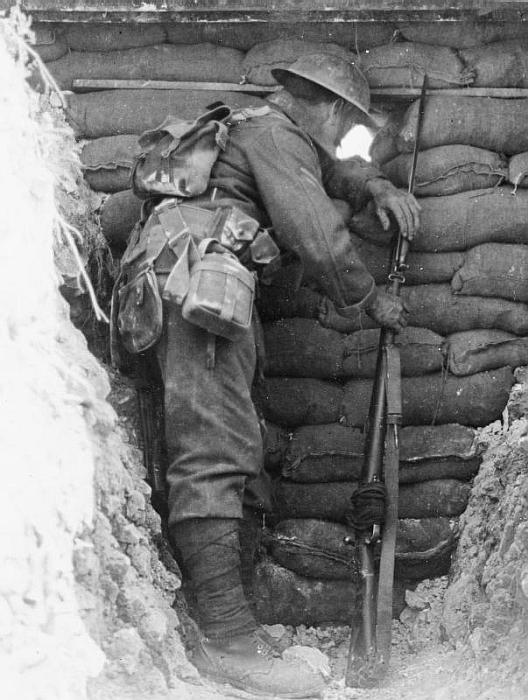
A sentry from the Worcestershire
Regiment manning a position
in France during 1916.
The freezing weather prevented the digging of assembly trenches and
the leading waves had to form up on lines of tapes, ready for the
attack to begin at 5.15 a.m. A creeping barrage [Note]
began on time and after five minutes began to lift. The first
objective at Pallas Trench was taken on time with few losses and at
the junction of the attacking brigades, a small section which held
out was quickly captured, before reverse-fire by the Germans there
could stop the troops who had passed beyond. Pallas Trench was
occupied by moppers-up and the attacking troops reached the second
objective at Fritz Trench on the right and Pallas Support Trench on
the left. Some troops advanced so swiftly that they went
beyond the objective to Fritz Trench and captured two machine-guns
before returning. This from the 1st Battalion War Diary
[Note]
for the 4th March, 1917, the day on which Private Wilkins was killed
in action
“BRAY
March 1917
1st: Batt marched from billets at BRAY to ASQUITH FLATS (Bgde
Reserve). Weather fair.
2nd: Billeted in dugouts ASQUITH FLATS. Later Bn left ASQUITH FLATS
evening of 2nd and took over trenches BOUCHAUESNES NORTH sector. Took over from 2nd DEVONS.
3rd: In trenches. Quiet, weather fair. One German walked into our
line and was captured night 2nd/3rd. Casualties Killed 1 O.R.
Wounded 6 O.R.
4th: Battalion in conjunction with 2nd Northants & 2/Royal Berks R
[egiment?]
attacked the German positions E of BOUCHAUESNES. Attack was
delivered at 5.30 am under a creeping barrage. [Note]
Order of Coys. A left Coy. D centre Coy. C right Coy. B support Coy.
Attack was quite successful after heavy bombing fights in places.
A great many Germans were killed, 2 machine guns were captured after
their crews had been killed, together with about 100 prisoners taken
by the Battalion. PALLAS TRENCH (German front line) & FRITZ
TRENCH (Support line) were captured. From FRITZ TRENCH
excellent observation was obtained over country near MOISLAINS &
excellent observation for our artillery was obtained. Enemy
shelling was very heavy & a barrage was kept up on captured lines &
lines of communication all day. The observation obtained from
FRITZ TRENCH enabled the Battn. to beat off counter attacks by means
of Lewis Guns [Note]
& rifle fire. Small German parties hurrying up from direction
of MOISLAINS were dispersed by Lewis Gun fire. Very heavy
casualties were sustained during the attack. The enemy’s
heavy shelling was responsible for the large proportion.
The Battn. was relieved by 2/West Yorks night 4th/5th. A heavy
barrage was kept up by the enemy during relief. Bn. proceeded to
ASQUITH FLATS on relief.
Casualties. Officers: killed 5, wounded 4; missing 1.
O.R.s: killed 44; wounded 158; missing 1.
5th. to 7th.: Billeted in ASQUITH FLATS. Recuperation
& cleaning up.”
German bombardments continued during the night of th/5th March,
before an attack on the British right flank, which captured a trench
block and about 100 yards of Fritz Trench to the north, before a
local counter-attack recovered the recaptured ground. German
artillery-fire continued all day and at 7,30 pm, German infantry
seen massing on the right flank were dispersed by artillery and
machine-gun barrages before they could attack. German
bombardments continued on the 6th March, before slowly diminishing,
but by then the 1st Battalion had left the line.
The operation cost the British 1,137 casualties; 217 German
prisoners and seven machine-guns were captured and “exceedingly
heavy” German casualties inflicted, according to surveys of the
vicinity after the German withdrawal to the Hindenburg Line. [Note]
The new positions menaced the German defences at Péronne and the
defences further south, which with the capture of Irles by the Fifth
Army on the 10th March, forced the Germans commence their retirement
towards the Hindenburg Line two weeks early than planned.
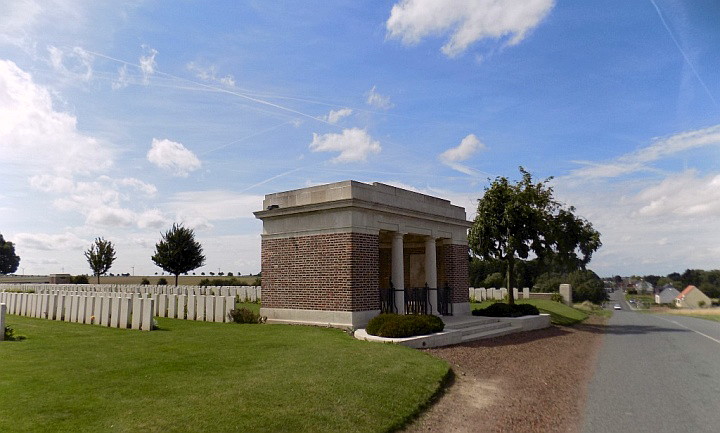
Fins and Sorel were occupied at the beginning of April 1917, in the
German Retreat to the Hindenburg Line. They were lost on the
23 March 1918, after a stubborn defence of Sorel by the 6th K.O.S.B.
and the staff of the South African Brigade, and they were regained
in the following September.
The first British burials at Fins were carried out in the Churchyard
and the Churchyard Extension, and the New British Cemetery was not
begun until July 1917. It was used by fighting units and Field
Ambulances until March, 1918, when it comprised about 590 graves in
Plots I to IV. It was then used by the Germans, who added 255
burials, including 26 British, in Plots IV, V, and VI. In
September and October 1918, about 73 British soldiers were buried by
the 33rd and other Divisions, partly in Plots I and II, but mainly
in Plots V and VI. Lastly, Plots VII and VIII were made, and
other Plots completed, by the concentration of 591 graves after
Armistice from the surrounding battlefields and from other smaller
cemeteries.
There are now 1289, First World War casualties commemorated in this
site. Of these 208 are unidentified, and special memorials are
erected to nine soldiers from the United Kingdom who are believed to
be buried among them. Another special memorial records the
name of a soldier from the United Kingdom, buried in Fins Churchyard
Extension, whose grave could not be found on concentration.
Nine graves in Plot VIII, Row E, identified as a whole but not
individually, are marked by headstones bearing the words: “Buried
near this spot.” There are also 276 German burials here,
89 being unidentified.
――――♦――――
OLIVER WILKINS
Bugler, 1st/1st Oxfordshire and Bucks Light Infantry, service no.
265633.
Son of Thomas and the late Maria Wilkins of Tring.
Killed in action on the 16th August 1917 aged 20.
Buried in New Irish Farm Cemetery, Belgium, grave ref. XII. E. 12.
The 1/1st Battalion (Territorial Force) [Note]
Ox and Bucks L.I. was formed at Aylesbury in August 1914.
Mobilised for war, the Battalion landed at Boulogne in March 1915.
In May it became part of the 145th Infantry Brigade of the 48th
Division, [Note]
thereafter engaging in various actions on the Western Front [Note]
including:
1916 – The Battle of Albert, The Battle of Bazentin Ridge, The
Battle of Pozieres Ridge, The Battle of the Ancre Heights, The
Battle of the Ancre.
1917 – The German Retreat to the Hindenburg Line, The Battle of
Langemarck, The Battle of Polygon Wood, The Battle of Broodseinde,
The Battle of Poelcapelle. In November the Battalion deployed
to Italy to stiffen Italian resistance to enemy attack after a
recent disaster at Caporetto.
1918 – The Division held the front line sector at the Montello and
then moved west, to the Asiago sector and then engaged in fighting
on the Asiago Plateau, The Battle of the Vittoria Veneto in Val
d’Assa. The Battalion ended the war near Trent, Austria.
The Battle of Langemarck (16th–18th August 1917) was the second
Allied general attack of the Third Battle of Ypres against the
German 4th Army.
So far as the 145th Infantry Brigade was concerned, the
objective was to capture the high ground overlooking the valley of
the Stroombeek. The order of battle of this Brigade was the
1/5th Battalion Gloucestershire Regiment on the right, the 1/1st
Bucks Battalion in the centre, the 1/4th Battalion Oxford and Bucks
Light Infantry on the left, with the 1/4th Battalion Royal Berkshire
Regiment in Brigade reserve.
The British front line on the Brigade front lay immediately west of
the Steenbeek, whilst the Germans were holding a line consisting of
organised shell-holes and reinforced houses, along the ridge 200
yards east of the stream. The Battalion was to form up for the
attack west of the Steenbeek, on a front of 500 yards immediately
north of the St. Julien bridge on the 16th August. The
formation was to be: two companies in front, A on the left and B on
the right, each in two waves of two platoons, with C and D in
artillery formation behind right and left respectively. Tanks
were to have co-operated, but owing to the waterlogged state of the
ground they were cancelled at the last moment.
Bugler Wilkins was killed in this action while “acting as a
runner in an attack by the Battalion on an enemy position early on
August 16th”; in other words carrying messages back to Battalion
HQ (see letter extract, Parish Magazine below). The
following is taken from the 1/1st Battalion War Diary: [Note]
DAMBRE CAMP
August 1917
11th: IN CAMP. During the day the Battalion carried
out a practice attack in connection with the forthcoming operation.
Weather wet and rather cold. Ration strength 22 officers, 806 O.R.
12th: IN CAMP. SUNDAY Church Parade Service. In the
afternoon OFFICERS and platoon SERGTS attended a lecture by the CRA
in connection with the forthcoming operation. During the
afternoon one of our KITE BALLOONS was brought down by an E.A.
[Enemy Aircraft], and later one
of the E.A. was brought down by gunfire.
At night 1 OFF and 16 OR went up the line to reconnoitre assembly
positions in connection with the forthcoming operations returning at
5.30 am. Ration strength 22 officers, 804 O.R. Weather
fine.
13th: IN CAMP. Battalion again carried out a practice
attack in connection with the forthcoming operations. Weather
fine. Ration strength 212 offs 804 OR.
14th: IN CAMP: Repeated practice attack of previous day during
morning. Ration strength 22 offs 806 OR.
15th: IN CAMP. Battn. marched by Coys at 200 yards
intervals to CANAL BANK leaving DAMBRE CAMP at 11 am in accordance
with W3. Dinner and teas eaten there. Men made to rest
the whole afternoon. Started moving from CANAL BANK by
platoons at 11pm. Route up to forming up positions – CORDUROY
track past HAMMONDS CORNER – JULIES FARM. Considerable delay
at HAMMONDS CORNER, owing to Lewis gun [Note]
limbers [Note]
not arriving in time, they having been blocked on the very dark
night. Zero to be at 4.45 am, 16th inst. Ration strength
22 offs 806 OR.
A, B, & D Coys formed up by Zero. Only 1 casualty. C Coy
late owing to above mentioned Lewis Gun limbers, & heavy enemy
shelling which they encountered on way up.
DISPOSITIONS
The Battalion in four waves. Each company on a two platoon
front.
A Coy on left & B Coy on right forming 1st two waves.
C Coy on left and D Coy on right forming 2nd two waves.
Battn. HQ at C12CO3
1/5th GLOUCESTER REGT on right.
1/4th OX & BUCKS LI on left.
1/4TH R. BERKS REGT in support.
OBJECTIVES
1st wave – HILLOCK FARM line of gunpits to its right.
2nd wave – Green line (SPOT FARM –
SPRINGFIELD –
LANGEMARCK Rd.)
3rd wave – Red line.
4th wave – Blue line – Right Coy – STROPPE FARM; Left Coy – GENOA &
HUBNER FARM.
For detailed objectives see 0025 paras 8. 9.10. 11. 12.
ARTILLERY
See 0026
NARRATIVE
Soon after leading company (A) reached its forming up position W of
STEENBEEK, enemy commenced to shell ground about 150 yds behind.
To keep all companies clear of this, the leading companies were sent
forward close to the stream. Two leading companies (A & B)
crossed stream at Zero – 7.
1 platoon C Coy arrived about this time. Remaining 3 platoons
did NOT arrive until Zero + 20 &, losing direction to the left,
were, so far as this Battn. was concerned, NO further assistance in
the attack.
The right of the leading wave lost a few men from our own barrage,
but this lifted before they could reach the ridge E of the STEENBEEK
and they came under very heavy machine gun fire while topping the
ridge. This fire was very rapidly reinforced by considerable
rifle fire from trenches to the sides and front of numerous concrete
blockhouses out of which the machine guns were firing. The
leading wave of the right company was almost entirely annihilated by
this fire. The second wave closed up and engaged the enemy
with fire, while parties worked round the flanks. But the enemy kept
up a very strong resistance & until the 3rd wave joined in & closed
on them with a rush they showed no signs of giving in.
After this charge there was a short bout of hand-to-hand fighting
before the enemy, in and around one house put up their hands.
This was about 6 am. After this the other garrisons soon
followed suit.
The left leading company met with less resistance at first, but
after going about 150 yds E of the STEENBEEK they came under a very
heavy crossfire from Machine Guns at a distance & the first wave
reached the gun pit line with about 16 men. The second wave
closed up but the left platoon was absolutely stopped by fire from
the left gun pit & a trench immediately N.E. of it, also from MAISON
DU HIBOU & TRIANGLE FARM.
The right half of the second wave went right through, passing S.E.
of HILLOCK FARM apparently taking with them the remains of the right
platoon of the 1st wave, altogether about 25 strong, & reached
SPRINGFIELD road to left of it about 6.45 am. Several of these
were seen to fall en route especially by line of gun pit about
C12a87. Six of our men were seen at SPRINGFIELD about 9 am &
four were seen led away by Germans about 9.30 am.
At about 7 am Battn. HQ moved forward to Blockhouse at C12a51. At
that time situation was as follows:
(a) Capt. PULLMAN, 2/Lt REEVES, with about 25 men & LGs holding line
from C12c96 – 78.
(b) About 15 men & 1 Lewis Gun C12c65 – 58
(c) About 20 men astride road in neighbourhood of HILLOCK FARM
(d) 1 officer & 6 OR at GUNPIT C12a34
(e) 4 men under a Cpl at C12a6245
(f) About 25 men & 1 Lewis Gun reported to have got through to
SPRINGFIELD
2/Lt PASSMORE, although slightly wounded was commanding left half of
the line & Capt. PULLMAN right half of the line.
On the right it was impossible to get on as there was a large sheet
of water in front and the ground all round was little short of a
morass, with a blockhouse and gunpit the far side held by enemy
Machine Guns & a number of snipers. Every attempt at movement
resulted in casualties. 2/Lt JOHNSTON was seriously wounded in
trying to get touch with this party of D Coy. Several attempts
were made to get forward on the left but all were stopped by enemy
MG fire. At this time there was no connection with the
Battalions on either flank.
About midday, casualties from enemy snipers & MG on the left had
become so numerous that we were forced to withdraw from HILLOCK FARM
& take up a position immediately to the South of it. This
proved to be but a slight improvement as enemy fire from TRIANGLE
FARM & MAISON DU HIBOU never stopped sweeping the TRIANGLE – ST
JULIEN Rd & the ground on either side of it.
Finally, at dusk, after an enemy counter attack, the left withdrew
to a line C12a23–C12a72–C12c88. The right consolidated their
positions consisting of a disused trench.
By evening it was evident that we did not hold SPRINGFIELD any
longer. A patrol set out to get there during the night but
lost their way.
ENEMY COUNTER ATTACKS
About 8am the enemy were seen to be coming over the ridge N of
SPRINGFIELD in threes and fours & dropping into a trench just SE of
crossroads C6d21. This continued for some time. About 9 am, two or
three lines of men came over the ridge & moved down towards TRIANGLE
FARM. There was also some attempt made to reinforce the gunpit
opposite our right. By this time a Vickers Gun had been mounted on
top of one of the blockhouses close to Battn. HQ & two others
arrived about this time & were quickly got into action in a trench
about C12a30. All available men round Battn. HQ were sent up to
reinforce the line round HILLOCK FARM. 1 platoon, 4th R Berks, was
asked for & put into position about C12a25, to protect left flank.
This platoon were in position by 10 am.
Our fire stopped the enemy advance about TRIANGLE FARM & after about
20 minutes many of them were seen returning over the ridge.
About 7.30pm, the enemy attempted to rush the gunpits at about
C12a24 but were stopped & suffered heavily.
At 9.30 pm he again attacked from direction of TRIANGLE FARM &
rushed our posts with bombs, succeding in driving them in [unclear
on this text].
The night passed without further incident.
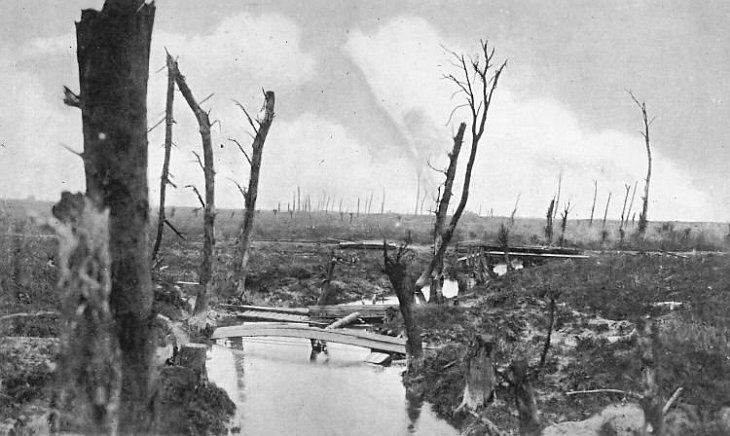
The Steenbeek the way the 1/1st Ox &
Bucks L.I. would have found it.
The enemy belonged to 7th Bavarian Infantry Regiment. The
attack proved that our barrage had no effect whatever on the
garrisons of concrete blockhouses, and that for future operations it
was essential that these should be dealt with by heavy artillery
prior to an assault. For such a comparatively small advance it
was a costly attack. Casualties reported in the 1st/1st
battalion War Diary (other sources give slightly different
figures) were officers; 1 killed (Capt. G. V. NEAVE) and 8 wounded.
Other ranks; 43 killed, 49 missing (14 later reported P.O.W.s), 189
wounded, 5 wounded slightly. Some of the wounded personnel
were described as “severe” and might later have
succumbed to their wounds.
From the Bucks Herald 1st September 1917:
“Pte. Oliver Wilkins, Oxford and Bucks L.I.,
has made the great sacrifice acting as a runner in an attack made by
the regiment on August 16. This young fellow was 20
years of age, and joined early in the war. He was formerly a
chorister at the Parish Church, and belonged to the Boy Scouts and
Church Lads Brigade. He had been home to England suffering
from shell shock, and returned to the front in May last.”
From the Parish Magazine September 1917:
“Of Oliver Wilkins his Captain writes: ‘He
was killed whilst acting as a runner in an attack by the Battalion
on an enemy position early on August 16th. He was renowned in
the battalion for his cheeriness. I picked him out of the
remainder of the company as a runner, a post which means a great
deal of common sense. He always carried out his duties in a
thoroughly efficient manner, and was always willing to perform any
duty asked of him.’ The Chaplain adds: ‘He was a good soldier
and very popular with the other men in the battalion.’
Oliver was for some years a chorister in our church; for some time
was a member of the Tring Troop, Boy Scouts and afterwards joined
our Church Lads’ Brigade. He enlisted in the Bucks Battalion
in September 1914 when he was only 17 years of age, and went to
France on March 30th 1915. He was home in England for sometime
suffering from severe shell shock, but returned to the front in May
1917. May god accept the life given.”
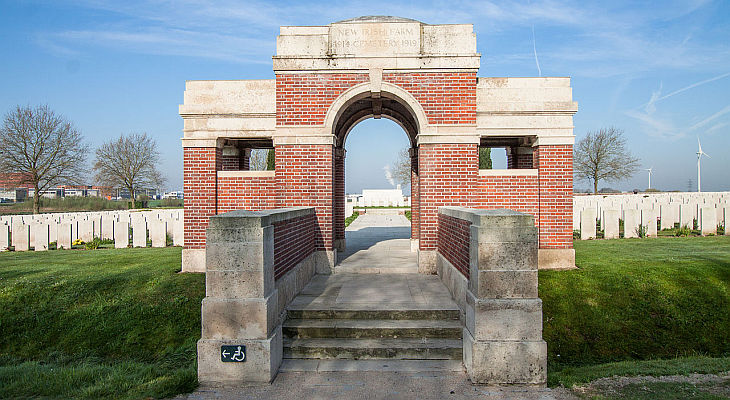
New Irish Farm Cemetery was first used from August to November 1917
and was named after a nearby farm, known to the troops as “Irish
Farm” (originally there was an Irish Farm Cemetery immediately South
of the Farm. New Irish Farm Cemetery is about 300 metres North
of the Farm at a crossing once known as Hammond’s Corner).
It was used again in April and May 1918 and at the Armistice it
contained just 73 burials, but was then greatly enlarged when more
than 4,500 graves were brought in from the battlefields north-east
of Ypres, including many soldiers from the United Kingdom who fell
in the Langemark area during August to October, 1917.
There are now 4,719 commonwealth servicemen of the First World War
buried or commemorated in this cemetery. 3,271 of the burials
are unidentified, but special memorials commemorate four casualties
known or believed to be buried among them. Other special
memorials record the names of 30 casualties buried in four of the
cemeteries removed to New Irish Farm whose graves were destroyed by
shell fire.
――――♦――――
SIDNEY WOODS
Private, 8th Bedfordshire Regiment, service no. 19523.
Husband of Maud and father to four children.
Died of wounds on the 3rd November 1916 aged 29.
Buried in St Sever Cemetery Extension, Rouen, France, grave ref. O. I. B. 5.
The 8th (Service) [Note] Battalion
was raised at Bedford in October 1914, as part of Lord Kitchener’s
3rd ‘call to arms’ [Note] for another
100,000 men to enlist into the expanding British Army.
Following mobilisation the Battalion landed at Boulogne on the 30th
August 1915. On the 17th November they Battalion became part
of 16th Brigade in the 6th Division, [Note]
thereafter serving entirely on the Western Front [Note]
where they played some part, with distinction, in every major battle
in which the British were involved.
In April 1916 the Battalion lost heavily during a massed bombardment
and raid on their lines. Later in the year they were engaged
in The Battles of the Somme (1916), specifically the Battle of
Flers-Courcelette (15th–22nd Sept) and the Battle of Morval
(25th–28th Sept), and the Battle of Le Transloy (1st–18th Oct), the
last 4th Army offensive in the (1916) Battle of the Somme.

Ampthill Training Camp, where Private
Woods enlisted.
There is nothing in the records I have to indicate when Private
Woods received his ultimately fatal wounds, which might have been
some weeks time before his death. But a look through the
Battalion War Diary [Note] suggests mid-October 1916 (Battle of Le
Transloy) is a strong possibility, for on several days in succession
the Diary records casualties:
“12 Oct: trenches east of
Gueudecourt. Relieved 1/KSLI [King’s Shropshire Light
Infantry] and 2/Y&L [York and
Lancaster Regiment] in trenches E. of
GUEUDECOURT at night. 2/Lt Sharpin wounded.
13 Oct: in trenches as above. Enemy artillery active
also snipers. Intense bombardment at 5.45 pm to 6.15 p.m.
Casualties 4 O.R. Killed 11 wounded.
14 Oct: in trenches as above. Artillery very active on
each side. Casualties 3 O.R. killed & 10 wounded.
15 Oct: in trenches as above. Intermittent shelling
whole day very intense for about half an hour at midnight 15/16.
Three Enemy snipers shot down. Casualties 2/Lt Gibson died of
wounds 2 O.R. killed, 8 wounded.
16 Oct: in trenches as above. Clear sky most of day
aircraft very active resulting in less hostile shelling during
daylight. Intense hostile shelling for half an hour commenced at
5.45 pm. Casualties 4 O.R. killed & 4 wounded. Another German
sniper shot down
17 Oct: in trenches as above. Artillery very
active all day on both sides. At 5 pm intense hostile
bombardment lasting 40 minutes. Casualties 4 killed 3
wounded.”
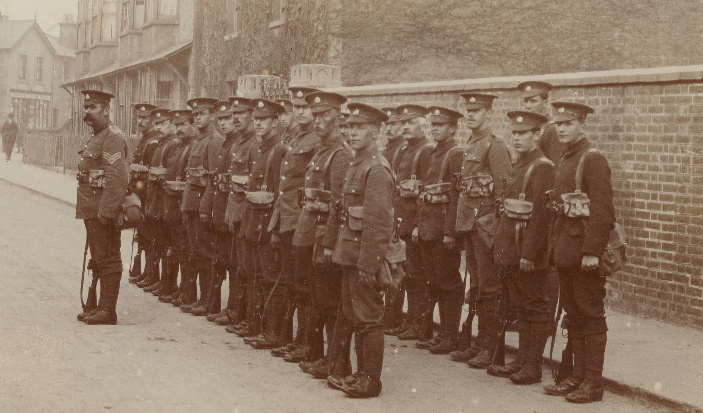
A squad of the 8th Battalion in Brighton
during their training in 1915, led
by one of the regular sergeants (they didn’t then know what awaited
them!).
Sidney Woods was born in 1887 at Ridgmont, Bedfordshire, into a farm
labouring family. In the 1911 Census (then aged 24) he is
recorded living at Aspley Guise, Bedfordshire, with his wife Maud
(aged 23, married in 1908), a daughter Florence (aged 2) and a baby
son Frederick, his occupation being ‘traction engine driver’.
This from the Bedfordshire Times and Independent 10th
November 1916:
“News of the death of Pte. Sidney Woods in
France from wounds, has been sent to his widow. Much sympathy
is felt for Mrs Woods who is a native of Husborne Crawley. She
is left with four young children.
The deceased soldier was well known over a wide district through his
work as a trashing machine hand. Prior to the war he left the
district to work at Tring, but came back to join up at Ampthill
Training Camp. [The Ampthill Command Depot Diary
lists Woods as from Bulbourne] He was
the youngest son of Mr. T. Woods, of Station Road. He was a
member of the village branch of the National Deposit Friendly
Society.”
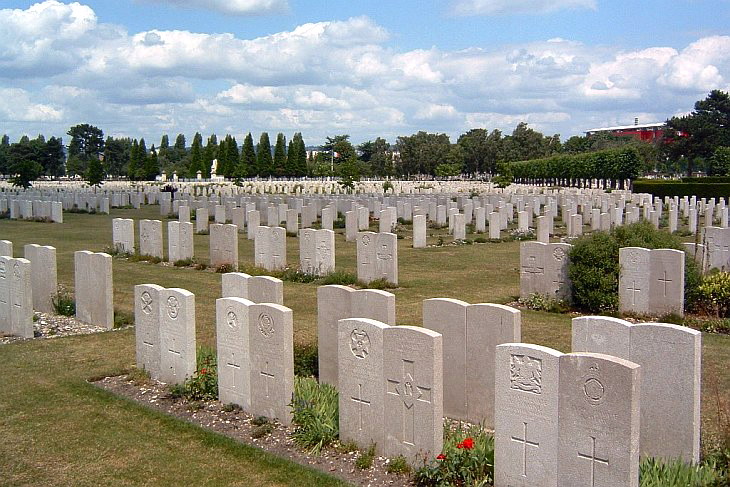
During the First World War, Commonwealth camps and hospitals were
stationed on the southern outskirts of Rouen. A base supply
depot and the 3rd Echelon of General Headquarters were also
established in the city. Almost all of the hospitals at Rouen
remained there for practically the whole of the war. They
included eight general, five stationary, one British Red Cross, one
labour hospital, and No. 2 Convalescent Depot. A number of the
dead from these hospitals were buried in other cemeteries, but the
great majority were taken to the city cemetery of St. Sever.
In September 1916, it was found necessary to begin an extension.
St. Sever Cemetery now contains 3,082 Commonwealth burials of the
First World War, plus 1 French burial and 1 non war service burial.
――――♦――――
ERNEST GEORGE WRIGHT
Private, 1st/4th Battalion Essex Regiment, service no. 201132.
7 New Cottages, Brook Street, Tring.
Husband of Ada Cato (formerly Wright).
Killed in action of the 3rd June 1917 aged 32.
Buried in the Kantara War Memorial Cemetery, Egypt, plot F 421.
The 1/4th Battalion was a Territorial unit formed in the Childers
Reforms of 1908 [Note] with its
headquarters in Brentwood. The 1/4th, together with the 1/5th,
1/6th and 1/7th battalions, formed the 161st (Essex) Brigade in
the 54th (East Anglian) Division. [Note]
After serving a period in home defence, the 161st Brigade landed at
Suvla Bay on the 12th August 1915 to reinforce the Gallipoli
Campaign. There the Brigade saw some hard fighting, but having
lost even more men to sickness it was withdrawn to Egypt before the
Gallipoli Peninsula was finally abandoned in the following January.
On the 16th December, the 1/4th Battalion landed in Alexandria.
After time in the desert west of Cairo and a period of absorbing
replacement officers and men, the Battalion arrived in Cairo on the
24th March 1916, later to be deployed eastwards to protect the Suez
Canal and its vital supply route – an area known as the Southern
Canal Section – from Turkish attacks across the Sinai Peninsula.
Early in 1917, the 161st Brigade crossed the Sinai Desert to take
part in the Palestine Campaign. [Note]
The first two British attempts (the First and Second Battles of
Gaza) to invade southern Palestine, held by the Ottoman Empire, were
fought in March and April and resulted in British defeats.
There followed a period when both sides held their lines of defence
from Gaza to Beersheba during which extensive entrenchments were
constructed. These were particularly strong where the trenches
almost converged at Gaza and Beersheba, while in the centre of the
line the Ottoman defences overlooked an almost flat plain, devoid of
cover, making a frontal attack virtually impossible.
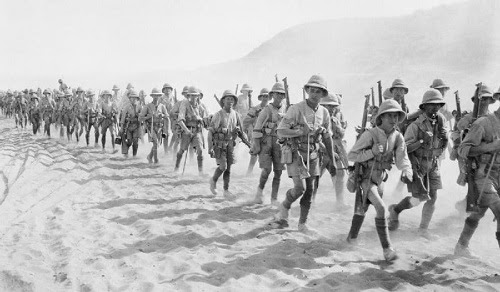
East Kent Regiment passing over the
Jebel Hamrin (Palestine),
December 1917.
Numerous raids on the pattern of those familiar on the Western Front
were carried out, although it was necessary to conduct almost all
operations at night due to the intense daytime heat. After
dark, as on the Western Front, trenches were raided and fighting
under exploding star shells and flares in no man’s land occurred,
while repairs and improvements to trenches were made, barbed wire
strung, communication trenches widened, cables buried, and gun
emplacements constructed. Judging from the date on which he
was killed, it seems likely that Private Wright fell during this
period of trench warfare.
The trench warfare extended from April to October 1917, when the
stalemate in Southern Palestine ended with the Allied victory at the
Battle of Beersheba.
From the Bucks Herald 23rd June 1917:
“ROLL OF HONOUR.
– Still another name has been added to the Roll of Honour of
residents of the town who have laid down their lives in the great
war. News has been received that Ernest George Wright of
Council Cottages, Brooke-street, was killed in action in Palestine
on June 3. Much sympathy is felt for the bereaved wife, who is
left with five children, ranging from 10 years of age to 15 months,
especially as this is her second great bereavement in a few weeks,
Mrs Wright being a sister of the late Albert Baldwin, whose death
occurred as the result of an accident with a traction engine.
Wright who was formerly in the employ of Mr. Frank Grace, as a
carter, was 32 years of age. He joined the Essex Regiment
early in the war, and after a few months service in France proceeded
to Egypt.”
From the Parish Magazine July 1917:
“Ernest George Wright was killed on 3rd
June 1917 in Palestine, two days after
Stanley Miller. He joined the
Army in June of 1915 and spent eight months with his regiment, the
4th Essex in France, afterwards proceeding to Egypt. No
further details have yet been received, but he will be remembered
here as one who fought and died bravely. May he rest in
peace.”
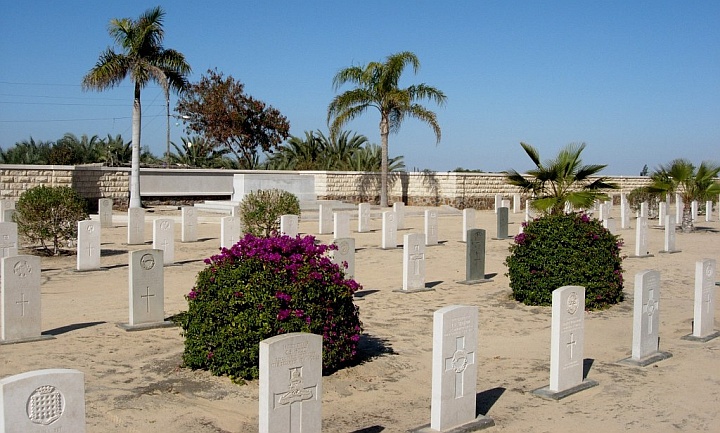
In the early part of the First World War, Kantara was an important
point in the defence of Suez against Turkish attacks and marked the
starting point of the new railway east towards Sinai and Palestine,
begun in January 1916. Kantara developed into a major base and
hospital centre and the cemetery was begun in February 1916 for
burials from the various hospitals, continuing in use until late
1920. After the Armistice, the cemetery was more than doubled
in size when graves were brought in from other cemeteries and desert
battlefields, notably those at Rumani, Qatia, El Arish and Rafa.
The Second World War again saw Kantara as a hospital centre.
No 1 General Hospital was there from July 1941 to December 1945 and
two others, Nos 41 and 92, were there in turn for varying periods.
One of the major allied medical units in the area, No 8 Polish
General Hospital, adjoined the war cemetery.
Kantara War Memorial Cemetery now contains 1,562 Commonwealth
burials of the First World War and 110 from the Second World War.
There are also 341 war graves of other nationalities in the
cemetery, many of them made from the Polish hospital and
concentrated in a distinct Polish extension.
――――♦――――
GEORGE WALTER YOUNG
Captain, 8th East Yorkshire Regiment.
Born in Tring. Son of George Thomas and Eleanor Young of 8 High Street,
Tring.
Killed in action in France on the 27th May 1918 aged 21.
No known grave. Commemorated on Soissons Memorial, France.
The 8th (Service) Battalion East Yorkshire Regiment was formed at
Beverley in September 1914 as part of Kitcherner’s Third New Army,
K3. [Note] The Battalion moved to
Tring and later to Godalming for training as part of the 62nd
Brigade of the 21st Division. [Note]
The Battalion mobilised for war, landing at Boulogne in September
1915 in time for the Battle of Loos (25th–28th September). In
November the Battalion was transferred to the 8th Brigade in the
3rd Division, thereafter engaging in many major actions on the
Western Front. [Note]
In February 1918 the Battalion disbanded, its remaining personnel
forming the 10th Entrenching Battalion. [Note].
In turn, the 10th Entrenching Battalion was disbanded in April, its
men joining the 7th Battalion East Yorkshire Regiment and 10th
Battalion West Yorkshire Regiment to make good the heavy losses
sustained early in the German Spring Offensive. [Note]
Following his death, correspondence received from the Battalion
informed Captain Young’s parents that “He was killed by a shell with several
others of his men on the Heights of Craonne on May 27th,” which
suggests that his Battalion was engaged in the 3rd Battle of the
Aisne (named after a river in north-eastern France). It was a
battle of the German Spring Offensive in which the Germans aimed to
capture the Chemin des Dames Ridge near Craonne.
The defence of the Aisne area was in the hands of General Denis
Auguste Duchêne, commander of the French Sixth Army. The
German attack came as a complete surprise. At 1 a.m. on the
morning of the 27th May the Germans began a bombardment of the
Allied front lines with some 4,000 artillery pieces. The
Allies suffered heavy losses because Duchêne was reluctant to
abandon the Chemin des Dames ridge after it had been captured at
heavy cost in the previous year, and had ordered them to mass
together in the front trenches in defiance of instructions from the
French Commander-in-Chief, Henri-Philippe Petain. Huddled
together, the Allied troops made easy artillery targets. The
result was massive destruction of the Allied front line and a huge
advance by German forces into open country. The fighting
continued until to the 6th June.
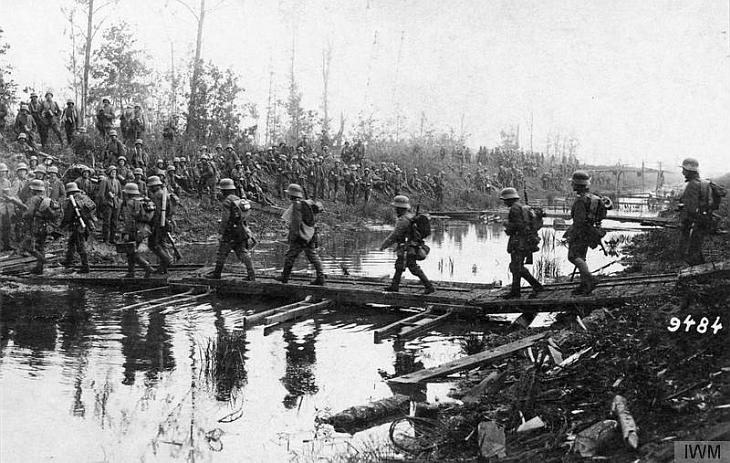
The morning of the first day of the
Battle of the Chemin des Dames, 27th May 1918.
German troops crossing a canal and awaiting orders to continue the
advance.
From the Bucks Herald 15th June 1918:
“ROLL OF HONOUR.
– The war has taken yet another toll of the brave lads of Tring by
the death of Capt. George W. Young, East Yorks, eldest son of Mr.
and Mrs. G. T. Young, of Tring Park Estate Office, with whom the most sincere sympathy is felt, especially
as their second eldest son, Lieut. M. Young [below] has not been heard of
for some considerable time, and has been missing since one of the
great battles of the recent offensive.
Capt. Young was only 21 years of age; he joined the Public Schools
Battalion early in the war, and on being promoted to a lieutenancy
in the East Yorks was for some time in training at Halton camp. He
went out with the 21st Division, and was wounded in the Battle of
Loos, since which time he has been wounded twice.
Going out to France for the fourth time on April 16 last, he served
with distinction in the great battles until May 27, when he met his
death, notification of which was received from the War Office on
Saturday. His Lieut.-Colonel, in a letter to Mr. Young, said that
Capt. Young fell on the heights of Craonne, doing splendid work, and
that his loss came as a great blow to the Battalion.”
From the Parish Magazine July 1918:
“George Walter Young, Captain 4th East
Yorks Regiment, joined the public schools Battalion on the out break
of the war. In October 1914, he got his commission as a 2nd/Lt
in the 8th East Yorks Regiment and came for training with the 21st
division at Halton Camp. He proceeded to France with the
division and was second in command of his company at the Battle of
Loos, where he was severely wounded. He was promoted to
Lieutenant, January 1915. When he recovered he re-joined his
regiment on 25 September 1915 and was again wounded during the
fighting at Munchy Le Prieux. He was made Captain early in
1917. As soon as he was strong enough he started off for
France again, and was wounded for the 3rd time at Noreuil on
December 17th 1917. Once more when he recovered and pleaded to
re-join his men, and crossed the Channel on 16th April 1918.
He was killed by a shell with several
others of his men on the Heights of Craonne on May 27th. His
Colonel writing says ‘He has done splendid work and his loss comes
as a great blow to the Regiment. We were awfully proud to have
him with us, and he will always remain a splendid memory, both for
his soldierly and personal qualities which bound everyone to him.’”

This fine memorial was designed by G H
Holt and V O Rees,
with sculpture by Eric Kennington.
At the end of April 1918, five divisions of Commonwealth forces (IX
Corps) were posted to the French 6th Army in this sector to rest and
refit following the German offensives on the Somme and Lys.
Here, at the end of May, they found themselves facing an
overwhelming German attack which, despite fierce opposition, pushed
the Allies back across the Aisne to the Marne. Having suffered
15,000 fatal casualties, IX Corps was withdrawn from this front in
early July, but was replaced by XXII Corps, who took part in the
Allied counter attack that had driven back the Germans by early
August and recovered the lost ground.
The Soissons Memorial commemorates almost 4,000 officers and men of
the United Kingdom forces who died during the Battles of the Aisne
and the Marne in 1918 and who have no known grave.
――――♦――――
MARCUS ERNEST YOUNG
Second Lieutenant, Royal Field Artillery.
Killed in action in France on the 24th March 1918 aged 19.
Son of Gorge Thomas and Eleannor Young of 8 High Street, Tring.
Buried in Chauny Communal Cemetery British Extension, France,
ref. FR 1893
Special Memorial “A”
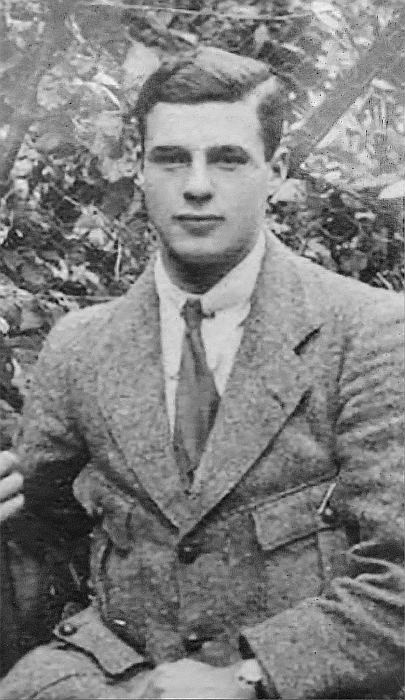
Marcus was the brother of George Young, whose name appears above.
From the Parish Magazine 1919:
“Marcus Ernest Young, 2nd/Lt R.F.A.
[Note]
left the Modern School Bedford in July of 1916, and joined the Army
in November of the same year, going through a course of training at
the R.F.A Barracks at St Johns Wood. In the following March he
was appointed to the Special Reserve of Officers and in June 1917
received orders to go to France. On March 22nd 1918 he was
reported missing, and subsequently, through the Red Cross in Geneva,
he was said to have been killed on that date and buried between La
Fere and Fargniers.
The Captain of his battery, when writing to his parents, said that:
‘He went over the top with an N.C.O in order to get information
about the guns which had been captured earlier in the day. He
did not return nor did the N.C.O. It was a very plucky thing
to do and was done on his own initiative.’” R.I.P.
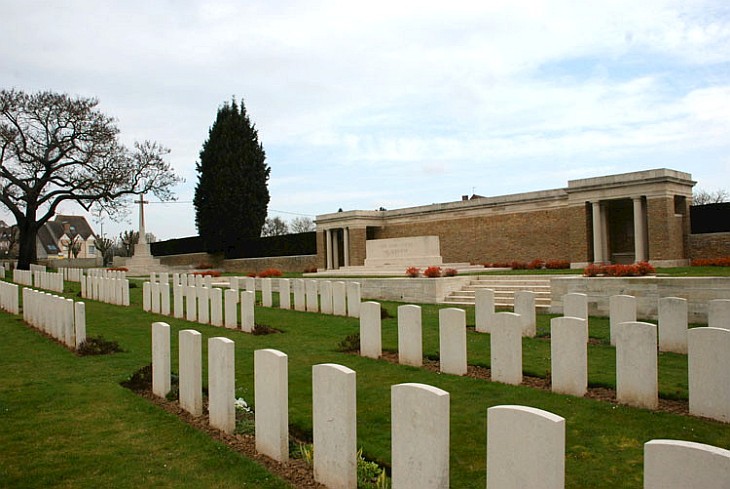
The Chauny Communal Cemetery British Extension was made after the
Armistice for the burial of remains brought in from the battlefields
of the Aisne and from smaller cemeteries in the surrounding
countryside. The majority of those buried here died in 1918;
among the rest were soldiers who fell in September, 1914. There are
just over 1,000, 1914-18 war casualties commemorated in this site.
Included in this figure is one soldier, whose grave is known to be
in the cemetery although the exact place of burial could not be
established. It is commemorated by a special memorial
headstone “A” inscribed ‘Buried in this cemetery’.
――――♦――――
Excluded names |
|